Paul van Yperen's Blog, page 79
July 31, 2023
Jacqueline Porel
Jacqueline Porel (1918–2012) was a French stage and film actress, best known for her role in Henri Georges Clouzot's La Verité (1960). She was also a voice actor, dubbing foreign films for release in French-speaking markets. She was married to the actors François Périer and Gérard Landry and the mother of actor Marc Porel, who died tragically in 1983.
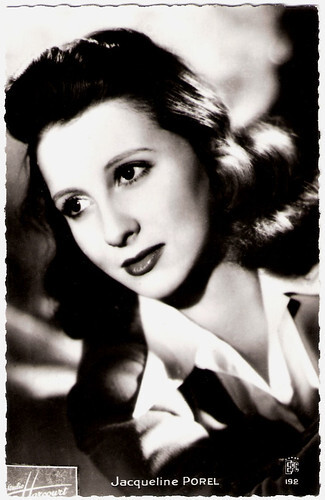
French postcard by EPC (Editions et Publications Cinematographiques), no. 192. Photo: Studio Harcourt.
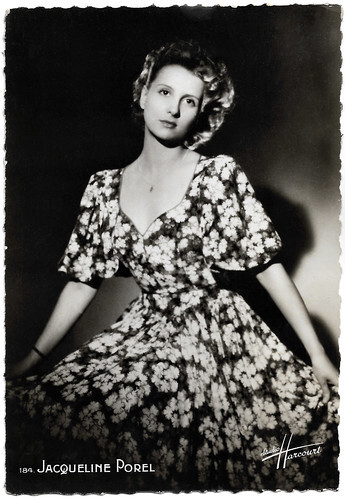
French postcard by S.E.R.P., Paris, no. 29. Photo: Studio Harcourt.
Granddaughter of Réjane
Jacqueline Renée Parfouru-Porel was born in 1918 in Divonne-les-Bains, Ain, France.
She was the daughter of author Jacques Porel and Anne-Marie Duval. Her godfather was the actor Louis Jouvet and her grandparents were the legendary actress Gabrielle Réjane and actor Paul Porel.
Jacqueline made her film debut in 1935 at the age of 17 in the comedy Les Beaux Jours/Sunny Days (Marc Allégret, 1935), starring Simone Simon , Jean-Pierre Aumont and Raymond Rouleau .
After she made her mark in the theatre, she played good supporting roles in such films as the musical Romance de Paris/Romance of Paris (Jean Boyer, 1941) starring Charles Trenet .
She played leading roles in films such as La grande meute/The Grand Pack (Jean de Limur, 1944), and the comedy Tierce à coeur/Third at Heart (Jacques de Casembroot, 1947) starring Georges Grey and Sophie Desmarets .
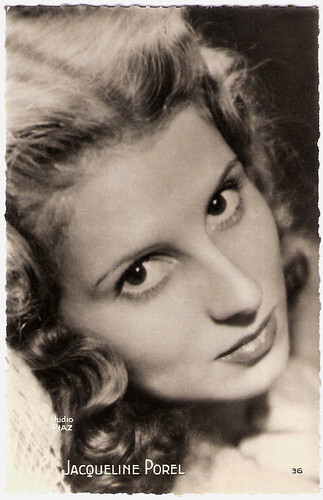
French postcard by Editions O.P., Paris, no. 36. Photo: Studio Piaz.
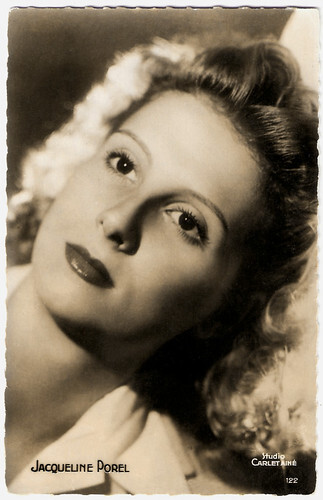
French postcard by Editions P.I., Paris, no. 122. Photo: Studio Carlet Ainé.
Brigitte Bardot's mother
After the war, Jacqueline Porel acted in the comedy-drama L'Appel du destin/The Call of Destiny (Georges Lacombe, 1953) starring Jean Marais .
According to Alexandre Carle at Les Gens du Cinéma , Porel played her best role in Henri Georges Clouzot's La Verité (1960) as the assistant to the defence lawyer ( Charles Vanel ) who was to take care of Brigitte Bardot .
She played Bardot's mother in Le Repos du guerrier/Love on a Pillow (Roger Vadim, 1962) and was in the all-star cast of the Emile Zola adaptation Germinal (Yves Allégret, 1963).
At the end of her career, she played in Jules Dassin's drama La Promesse de l'aube/Promise at Dawn (1970) starring Melina Mercouri . Porel has dubbed many actresses in French, including Deborah Kerr , Audrey Hepburn and Lana Turner , and has directed the French adaptation of many films. She retired in the early 1990s.
Jacqueline Porel died in 2012 in Boulogne-Billancourt, Hauts-de-Seine, France. She married and divorced actor François Périer (1941-1947), actor Gérard Landry (1948-1952)) and Jacques Brunet (1964-1968). She was the mother of actor Marc Porel with Gérard Landry, photographer Jean-Marie Périer with singer Henri Salvador and Jean-Pierre Périer-Pillu and journalist Anne-Marie Périer with François Périer.
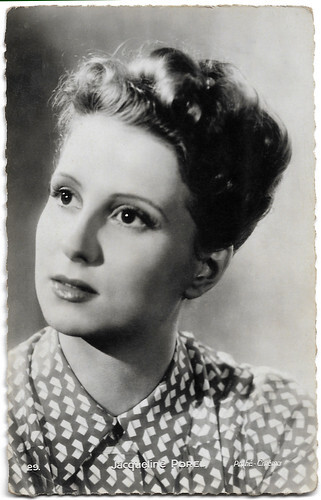
French postcard by Editions Chantal, Rueil (S.O.), no. 29. Photo: Pathé-Cinema.
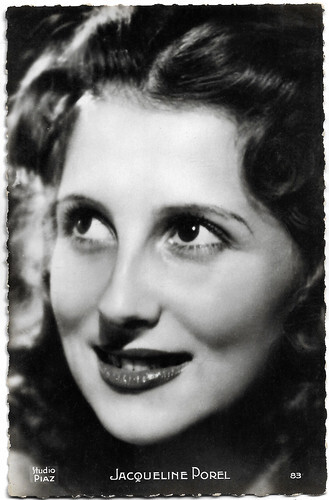
French postcard by Editions P.I., Paris, no. 83. Photo: Studio Piaz.
Sources: Alexandre Carle (Les Gens du Cinéma - French), Wikipedia (French and English) and .

French postcard by EPC (Editions et Publications Cinematographiques), no. 192. Photo: Studio Harcourt.

French postcard by S.E.R.P., Paris, no. 29. Photo: Studio Harcourt.
Granddaughter of Réjane
Jacqueline Renée Parfouru-Porel was born in 1918 in Divonne-les-Bains, Ain, France.
She was the daughter of author Jacques Porel and Anne-Marie Duval. Her godfather was the actor Louis Jouvet and her grandparents were the legendary actress Gabrielle Réjane and actor Paul Porel.
Jacqueline made her film debut in 1935 at the age of 17 in the comedy Les Beaux Jours/Sunny Days (Marc Allégret, 1935), starring Simone Simon , Jean-Pierre Aumont and Raymond Rouleau .
After she made her mark in the theatre, she played good supporting roles in such films as the musical Romance de Paris/Romance of Paris (Jean Boyer, 1941) starring Charles Trenet .
She played leading roles in films such as La grande meute/The Grand Pack (Jean de Limur, 1944), and the comedy Tierce à coeur/Third at Heart (Jacques de Casembroot, 1947) starring Georges Grey and Sophie Desmarets .

French postcard by Editions O.P., Paris, no. 36. Photo: Studio Piaz.

French postcard by Editions P.I., Paris, no. 122. Photo: Studio Carlet Ainé.
Brigitte Bardot's mother
After the war, Jacqueline Porel acted in the comedy-drama L'Appel du destin/The Call of Destiny (Georges Lacombe, 1953) starring Jean Marais .
According to Alexandre Carle at Les Gens du Cinéma , Porel played her best role in Henri Georges Clouzot's La Verité (1960) as the assistant to the defence lawyer ( Charles Vanel ) who was to take care of Brigitte Bardot .
She played Bardot's mother in Le Repos du guerrier/Love on a Pillow (Roger Vadim, 1962) and was in the all-star cast of the Emile Zola adaptation Germinal (Yves Allégret, 1963).
At the end of her career, she played in Jules Dassin's drama La Promesse de l'aube/Promise at Dawn (1970) starring Melina Mercouri . Porel has dubbed many actresses in French, including Deborah Kerr , Audrey Hepburn and Lana Turner , and has directed the French adaptation of many films. She retired in the early 1990s.
Jacqueline Porel died in 2012 in Boulogne-Billancourt, Hauts-de-Seine, France. She married and divorced actor François Périer (1941-1947), actor Gérard Landry (1948-1952)) and Jacques Brunet (1964-1968). She was the mother of actor Marc Porel with Gérard Landry, photographer Jean-Marie Périer with singer Henri Salvador and Jean-Pierre Périer-Pillu and journalist Anne-Marie Périer with François Périer.

French postcard by Editions Chantal, Rueil (S.O.), no. 29. Photo: Pathé-Cinema.

French postcard by Editions P.I., Paris, no. 83. Photo: Studio Piaz.
Sources: Alexandre Carle (Les Gens du Cinéma - French), Wikipedia (French and English) and .
Published on July 31, 2023 22:00
July 30, 2023
Sybille Schmitz
Beautiful German actress Sybille Schmitz (1909-1955) started her career in the era of silent cinema. With her typical face and her relaxed, slightly mysterious way of playing, she became a prominent Ufa star during the Third Reich. After the war, she was beset by drug abuse and depression and at 45, she committed suicide.
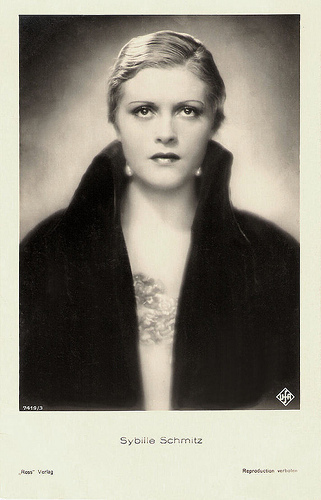
German postcard by Ross Verlag, no. 7419/3, 1932-1933. Photo: Ufa.
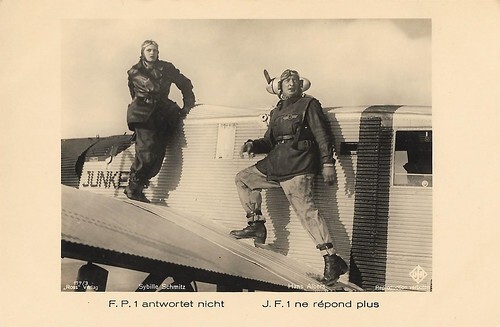
German postcard by Ross Verlag, no. 177/3, 1932-1933. Photo: Ufa. Sybille Schmitz and Hans Albers in F.P.1 antwortet nicht/F.P.1 Doesn't Answer (Karl Hartl, 1932).
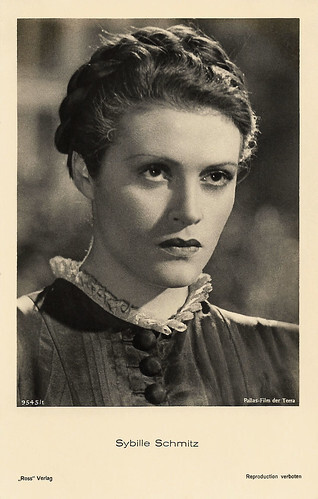
German postcard by Ross Verlag, no. 9545/1, 1935-1936. Photo: Pallas-Film der Terra. Sybille Schmitz in Fährmann Maria/Ferryman Maria (Frank Wisbar, 1936).
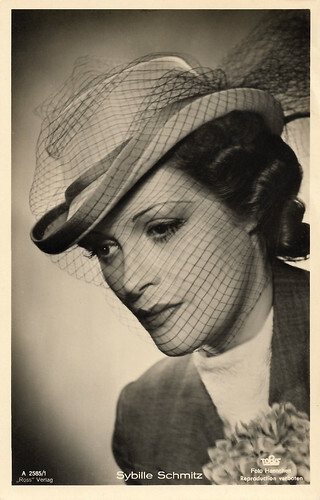
German postcard by Ross Verlag, no. A 2585/1, 1939-1940. Photo: Haenchen / Tobis. This was possibly a publicity photo for the upcoming spectacle Titanic (Herbert Selpin, Werner Klingler, 1943), which had a long production period. Director Herbert Selpin was arrested by the Gestapo during the film's production. He was found hanged in his cell the following day. After seeing the film, Propaganda Minister Goebbels thought the scenes of mass panic were not appropriate viewing for Germans who were then being subjected to British bombing. So he allowed only a foreign release, with the film premiering in Paris in 1943. Sybille Schmitz was the leading lady of Titanic.
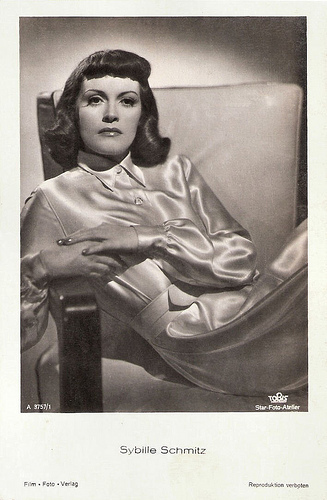
German postcard by Film-Foto-Verlag, no. A 3757/1, 1941-1944. Photo: Star-Foto Atelier / Tobis.
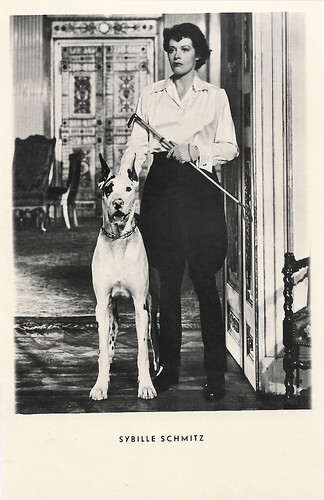
West German postcard by Netter's Star Verlag, Berlin, no. A 445.
Diary of a lost girl
Sybille Maria Christina Schmitz was born in Düren, in the West of Germany, in 1909. She was the daughter of a confectioner. Schmitz attended an acting school in Köln (Cologne) and got her first engagement at Max Reinhardt's Deutsches Theater in Berlin in 1927. Reinhardt was the most famous stage director of the Weimar Republic.
Only one year later, she made her film debut with the SPD party film Freie Fahrt/Free Ride (1928). Her role as a mother who dies of premature birth attracted her first attention from critics. Her other early films include Tagebuch einer Verlorenen/Diary of a Lost Girl (Georg Wilhelm Pabst, 1929) starring Louise Brooks , and Vampyr/Castle of Doom (Carl Theodor Dreyer, 1932) as the haunting beauty Leone. Her beautiful face with the shy look, enormous brooding eyes and sad mouth had a touch of strangeness and loneliness.
In the following years, she often played a mysterious and unapproachable woman. She played her first leading role in the Sci-Fi film F.P.1 antwortet nicht/F.P.1 Doesn't Answer (Karl Hartl, 1932) opposite Hans Albers . Schmitz then established herself as a prominent Ufa star with Der Herr der Welt/Master of the World (Harry Piel, 1934), Abschiedswalzer/Farewell Waltz (Géza von Bolváry, 1934), the Oscar Wilde adaptation Ein idealer Gatte/An Ideal Husband (Herbert Selpin, 1935) with Brigitte Helm , and the horror thriller Fährmann Maria/Death and the Maiden (Frank Wisbar, 1936), in which she played a ferrywoman attempting to save a doomed youth from Death.
Schmitz and the alcoholic director Frank Wisbar lived some years together. Nazi minister of propaganda, Joseph Goebbels, disliked her and thought her 'too foreign'. Schmitz suffered blacklisting by the regime for a while but stage director Gustaf Gründgens persuaded Goebbels to allow her to star in Der Tanz auf dem Vulkan/Dancing on the Volcano (Hans Steinhoff, 1938), one of the many circus melodramas made during the Nazi regime.
She then had roles in Die Frau ohne Vergangenheit/The Mysterious Woman (Nunzio Malasomma, 1939), Trenck, der Pandur (Herbert Selpin, 1940) with Hans Albers , and Titanic (Herbert Selpin, 1943), a technically amazing – for 1943 – film version of the sinking of the British luxury liner in 1912. According to Hans J. Wollstein at All Movie, the film “was promptly banned by Goebbels for being too depressing and not anti-British enough. The drama survives, however, and Schmitz once again offers a standout performance.”
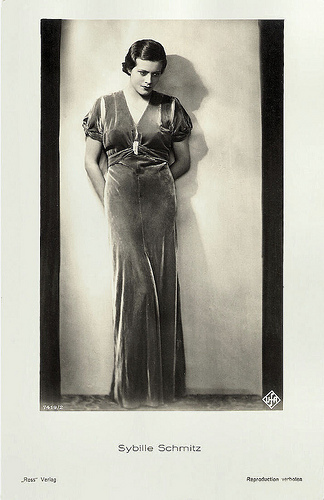
German postcard by Ross Verlag, no. 7419/2, 1932-1933. Photo: Ufa.
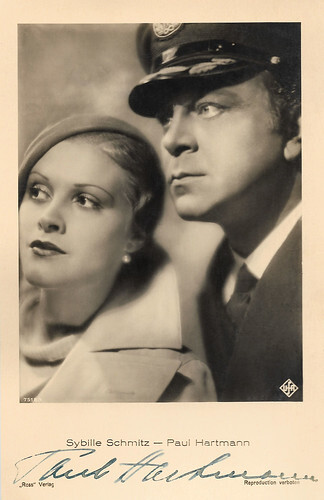
German postcard by Ross Verlag, no. 7518/1, 1932-1933. Photo: Ufa. Sybille Schmitz and Paul Hartmann in F.P.1 antwortet nicht/F.P.1 Doesn't Answer (Karl Hartl, 1932).
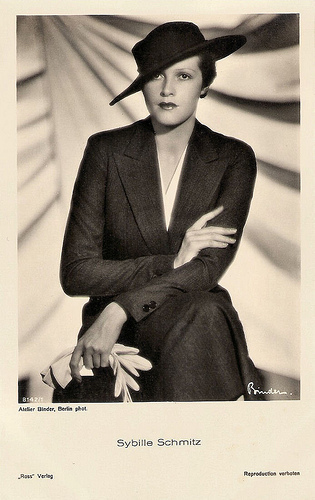
German postcard by Ross Verlag, no. 8142/1, 1933-1934. Photo: Atelier Binder, Berlin.
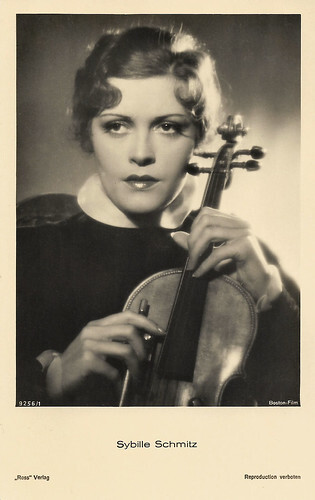
German postcard by Ross Verlag, no. 9256/1, 1935-1936. Photo: Boston-Film. Sybille Schmitz in Stradivari (Géza von Bolváry, 1935).
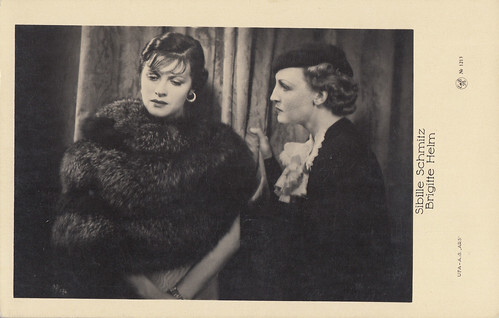
Latvian postcard by EMBR, no. 1213. Photo: Ufa. Brigitte Helm (right) and Sybille Schmitz in Ein idealer Gatte/An Ideal Husband (Herbert Selpin, 1935). Collection: Marlene Pilaete.
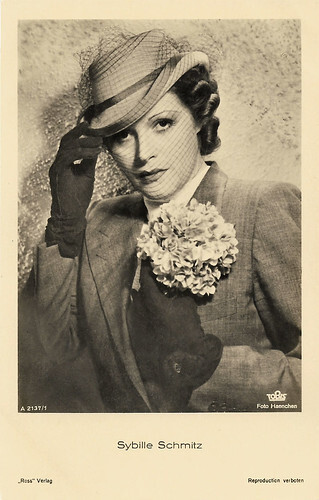
German postcard by Ross Verlag, no. A 2137/1, 1939-1940. Photo: Haenchen / Tobis. This was possibly a publicity photo for the upcoming spectacle Titanic (Herbert Selpin, Werner Klingler, 1943), which had a long production period. Director Herbert Selpin was arrested by the Gestapo during the film's production. He was found hanged in his cell the following day. After seeing the film, Propaganda Minister Goebbels thought the scenes of mass panic were not appropriate viewing for Germans who were then being subjected to British bombing. So he allowed only a foreign release, with the film premiering in Paris in 1943. Sybille Schmitz was the leading lady of Titanic.
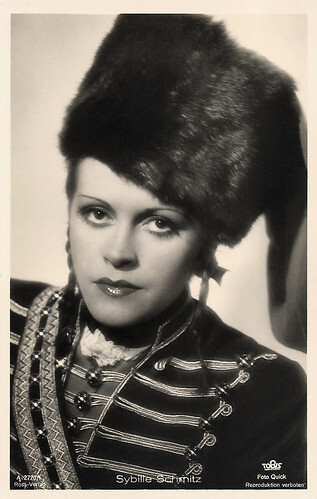
German postcard by Ross Verlag, no. A 2720/1, 1939-1940. Photo: Quick / Tobis. Sybille Schmitz in Trenck, der Pandur (Herbert Selpin, 1940).
Drug abuse, depression, suicide attempts
After World War II, Sybille Schmitz was shunned by the German film community for continuously working during the Third Reich, and it became difficult for her to land roles.
She appeared in supporting roles in such films as Zwischen gestern und morgen/Between Yesterday and Tomorrow (Harald Braun, 1947) starring Hildegard Knef , Sensation im Savoy (Eduard von Borsody, 1950), and Illusion in Moll/Illusion in a Minor Key (Rudolf Jugert, 1952), but was beset with drug abuse, depression, several suicide attempts and the committal to a psychiatric clinic.
In 1940 she married author Harald G. Petersson who wrote many of her screenplays and later would write the screenplays for the Winnetou films. Schmitz was bisexual and had a relationship with acting teacher Beate von Molo. Petersson could not cope with his wife’s bisexuality and her ever-increasing consumption of alcohol, so they went their separate ways.
Ironically, the last film she made less than two years before taking her own life, Das Haus an der Küste/The House on the Coast (Bosko Kosanovic, 1953 - now considered a lost film), had Sybille's character committing suicide as a last act of desperation. In 1955, Sybille Schmitz took a fatal overdose of sleeping pills in Munich. She was 45 years old. Schmitz left a note, not blaming anyone in particular for her death and stating that she simply grew weary of her life.
One year later, an action was brought against her doctor, Dr. Ursula Moritz, for improper medical treatment. Sybille Schmitz's tragic final years inspired Rainer Werner Fassbinder to his acclaimed film Die Sehnsucht der Veronika Voss/Veronika Voss (1982) with Rosel Zech as the tragic film star of the title.
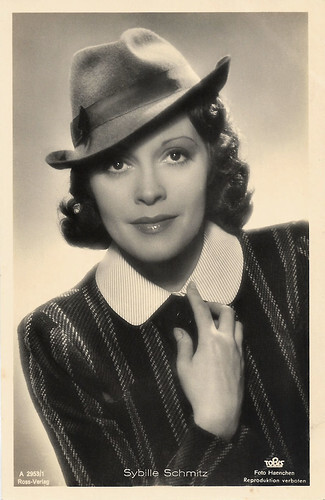
German postcard by Ross Verlag, no. A 2953/1, 1939-1940. Photo: Haenchen / Tobis.
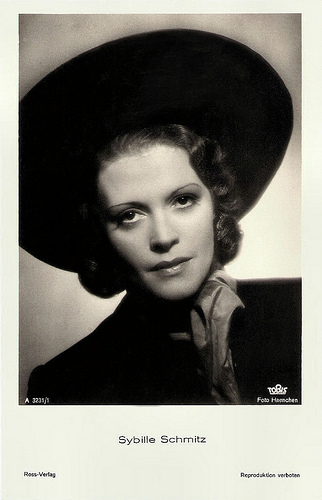
German postcard by Film-Foto-Verlag, nr. A 3231/1, 1941-1944. Photo: K.L. Haenchen, Berlin / Tobis.
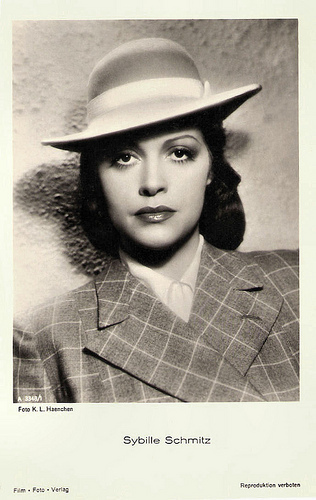
German postcard by Film-Foto-Verlag, no. A 3348/1, 1941-1944. Photo: K.L. Haenchen, Berlin.
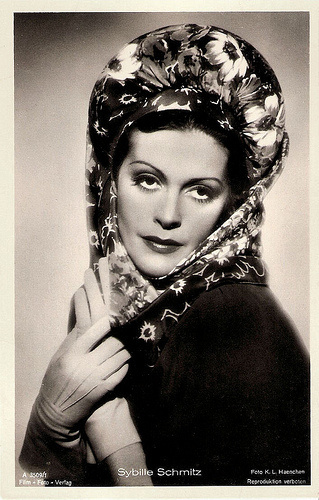
German postcard by Film-Foto-Verlag, no. A 3509/1, 1941-1944. Photo: K.L. Haenchen, Berlin.
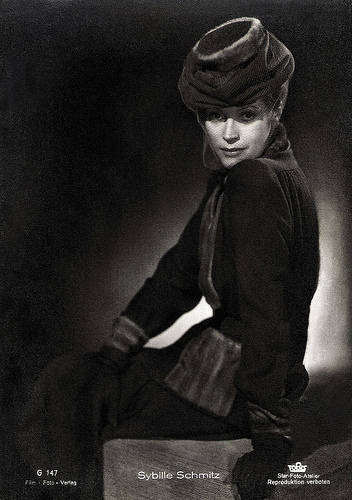
German postcard by Film-Foto-Verlag, no. G 147, 1941-1944. Photo: Star-Foto Atelier / Tobis.
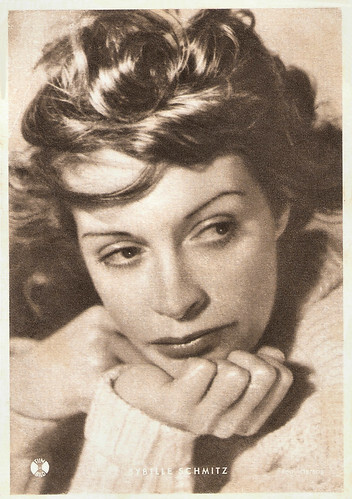
German postcard by Film und Bild, Frankfurt a. Main, offered by Warta soap. Photo: Real / Herzog.
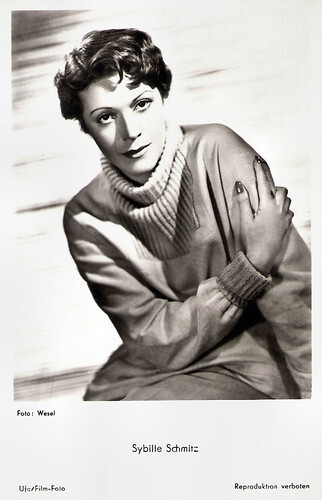
West German postcard by Ufa/Film-Foto, Berlin-Tempelhof, no FK 803. Photo: Wesel. Sent by mail in 1961.
Sources: U. Pothoff (Sybille Schmitz – Die Unbekannte), Hans J. Wollstein (AllMovie), Thomas Staedeli (Cyranos), Wikipedia and .

German postcard by Ross Verlag, no. 7419/3, 1932-1933. Photo: Ufa.

German postcard by Ross Verlag, no. 177/3, 1932-1933. Photo: Ufa. Sybille Schmitz and Hans Albers in F.P.1 antwortet nicht/F.P.1 Doesn't Answer (Karl Hartl, 1932).

German postcard by Ross Verlag, no. 9545/1, 1935-1936. Photo: Pallas-Film der Terra. Sybille Schmitz in Fährmann Maria/Ferryman Maria (Frank Wisbar, 1936).

German postcard by Ross Verlag, no. A 2585/1, 1939-1940. Photo: Haenchen / Tobis. This was possibly a publicity photo for the upcoming spectacle Titanic (Herbert Selpin, Werner Klingler, 1943), which had a long production period. Director Herbert Selpin was arrested by the Gestapo during the film's production. He was found hanged in his cell the following day. After seeing the film, Propaganda Minister Goebbels thought the scenes of mass panic were not appropriate viewing for Germans who were then being subjected to British bombing. So he allowed only a foreign release, with the film premiering in Paris in 1943. Sybille Schmitz was the leading lady of Titanic.

German postcard by Film-Foto-Verlag, no. A 3757/1, 1941-1944. Photo: Star-Foto Atelier / Tobis.

West German postcard by Netter's Star Verlag, Berlin, no. A 445.
Diary of a lost girl
Sybille Maria Christina Schmitz was born in Düren, in the West of Germany, in 1909. She was the daughter of a confectioner. Schmitz attended an acting school in Köln (Cologne) and got her first engagement at Max Reinhardt's Deutsches Theater in Berlin in 1927. Reinhardt was the most famous stage director of the Weimar Republic.
Only one year later, she made her film debut with the SPD party film Freie Fahrt/Free Ride (1928). Her role as a mother who dies of premature birth attracted her first attention from critics. Her other early films include Tagebuch einer Verlorenen/Diary of a Lost Girl (Georg Wilhelm Pabst, 1929) starring Louise Brooks , and Vampyr/Castle of Doom (Carl Theodor Dreyer, 1932) as the haunting beauty Leone. Her beautiful face with the shy look, enormous brooding eyes and sad mouth had a touch of strangeness and loneliness.
In the following years, she often played a mysterious and unapproachable woman. She played her first leading role in the Sci-Fi film F.P.1 antwortet nicht/F.P.1 Doesn't Answer (Karl Hartl, 1932) opposite Hans Albers . Schmitz then established herself as a prominent Ufa star with Der Herr der Welt/Master of the World (Harry Piel, 1934), Abschiedswalzer/Farewell Waltz (Géza von Bolváry, 1934), the Oscar Wilde adaptation Ein idealer Gatte/An Ideal Husband (Herbert Selpin, 1935) with Brigitte Helm , and the horror thriller Fährmann Maria/Death and the Maiden (Frank Wisbar, 1936), in which she played a ferrywoman attempting to save a doomed youth from Death.
Schmitz and the alcoholic director Frank Wisbar lived some years together. Nazi minister of propaganda, Joseph Goebbels, disliked her and thought her 'too foreign'. Schmitz suffered blacklisting by the regime for a while but stage director Gustaf Gründgens persuaded Goebbels to allow her to star in Der Tanz auf dem Vulkan/Dancing on the Volcano (Hans Steinhoff, 1938), one of the many circus melodramas made during the Nazi regime.
She then had roles in Die Frau ohne Vergangenheit/The Mysterious Woman (Nunzio Malasomma, 1939), Trenck, der Pandur (Herbert Selpin, 1940) with Hans Albers , and Titanic (Herbert Selpin, 1943), a technically amazing – for 1943 – film version of the sinking of the British luxury liner in 1912. According to Hans J. Wollstein at All Movie, the film “was promptly banned by Goebbels for being too depressing and not anti-British enough. The drama survives, however, and Schmitz once again offers a standout performance.”

German postcard by Ross Verlag, no. 7419/2, 1932-1933. Photo: Ufa.

German postcard by Ross Verlag, no. 7518/1, 1932-1933. Photo: Ufa. Sybille Schmitz and Paul Hartmann in F.P.1 antwortet nicht/F.P.1 Doesn't Answer (Karl Hartl, 1932).

German postcard by Ross Verlag, no. 8142/1, 1933-1934. Photo: Atelier Binder, Berlin.

German postcard by Ross Verlag, no. 9256/1, 1935-1936. Photo: Boston-Film. Sybille Schmitz in Stradivari (Géza von Bolváry, 1935).

Latvian postcard by EMBR, no. 1213. Photo: Ufa. Brigitte Helm (right) and Sybille Schmitz in Ein idealer Gatte/An Ideal Husband (Herbert Selpin, 1935). Collection: Marlene Pilaete.

German postcard by Ross Verlag, no. A 2137/1, 1939-1940. Photo: Haenchen / Tobis. This was possibly a publicity photo for the upcoming spectacle Titanic (Herbert Selpin, Werner Klingler, 1943), which had a long production period. Director Herbert Selpin was arrested by the Gestapo during the film's production. He was found hanged in his cell the following day. After seeing the film, Propaganda Minister Goebbels thought the scenes of mass panic were not appropriate viewing for Germans who were then being subjected to British bombing. So he allowed only a foreign release, with the film premiering in Paris in 1943. Sybille Schmitz was the leading lady of Titanic.

German postcard by Ross Verlag, no. A 2720/1, 1939-1940. Photo: Quick / Tobis. Sybille Schmitz in Trenck, der Pandur (Herbert Selpin, 1940).
Drug abuse, depression, suicide attempts
After World War II, Sybille Schmitz was shunned by the German film community for continuously working during the Third Reich, and it became difficult for her to land roles.
She appeared in supporting roles in such films as Zwischen gestern und morgen/Between Yesterday and Tomorrow (Harald Braun, 1947) starring Hildegard Knef , Sensation im Savoy (Eduard von Borsody, 1950), and Illusion in Moll/Illusion in a Minor Key (Rudolf Jugert, 1952), but was beset with drug abuse, depression, several suicide attempts and the committal to a psychiatric clinic.
In 1940 she married author Harald G. Petersson who wrote many of her screenplays and later would write the screenplays for the Winnetou films. Schmitz was bisexual and had a relationship with acting teacher Beate von Molo. Petersson could not cope with his wife’s bisexuality and her ever-increasing consumption of alcohol, so they went their separate ways.
Ironically, the last film she made less than two years before taking her own life, Das Haus an der Küste/The House on the Coast (Bosko Kosanovic, 1953 - now considered a lost film), had Sybille's character committing suicide as a last act of desperation. In 1955, Sybille Schmitz took a fatal overdose of sleeping pills in Munich. She was 45 years old. Schmitz left a note, not blaming anyone in particular for her death and stating that she simply grew weary of her life.
One year later, an action was brought against her doctor, Dr. Ursula Moritz, for improper medical treatment. Sybille Schmitz's tragic final years inspired Rainer Werner Fassbinder to his acclaimed film Die Sehnsucht der Veronika Voss/Veronika Voss (1982) with Rosel Zech as the tragic film star of the title.

German postcard by Ross Verlag, no. A 2953/1, 1939-1940. Photo: Haenchen / Tobis.

German postcard by Film-Foto-Verlag, nr. A 3231/1, 1941-1944. Photo: K.L. Haenchen, Berlin / Tobis.

German postcard by Film-Foto-Verlag, no. A 3348/1, 1941-1944. Photo: K.L. Haenchen, Berlin.

German postcard by Film-Foto-Verlag, no. A 3509/1, 1941-1944. Photo: K.L. Haenchen, Berlin.

German postcard by Film-Foto-Verlag, no. G 147, 1941-1944. Photo: Star-Foto Atelier / Tobis.

German postcard by Film und Bild, Frankfurt a. Main, offered by Warta soap. Photo: Real / Herzog.

West German postcard by Ufa/Film-Foto, Berlin-Tempelhof, no FK 803. Photo: Wesel. Sent by mail in 1961.
Sources: U. Pothoff (Sybille Schmitz – Die Unbekannte), Hans J. Wollstein (AllMovie), Thomas Staedeli (Cyranos), Wikipedia and .
Published on July 30, 2023 22:00
July 29, 2023
La Collectionneuse: Joan Fontaine
In the second half of the 1930s, Joan Fontaine mostly played nondescript roles on screen and stayed in the shadow of her more famous sister, Olivia de Havilland. Everything changed thanks to Rebecca (1940), produced by David O’Selznick and directed by Alfred Hitchcock. All of a sudden, she became hot property in Hollywood and was at the height of her career during the 1940s.
If she could perfectly play sweet and restrained characters in films, she was quite different in real life, as periods of estrangement from her daughters and her sister would suggest. However, Joan’s relationship with some other people seems to have been more cordial. Susan Pfeiffer, her secretary in later years, described her as 'one of the kindest, loving women I have ever met' and Police Officer Bill Cassara, who met her in 1997 and befriended her, reminisced in 2021 about 'her warm conversation and company'.
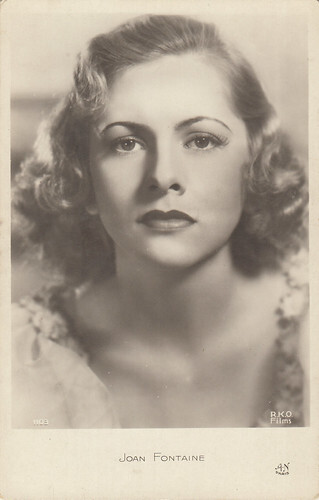
French postcard by A.N. Paris, no. 1103. Photo: RKO Films.
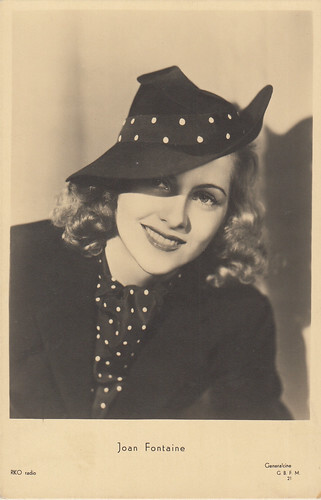
Italian postcard by G.B. Falci Editore, Milano, no. 21. Photo: RKO Radio.
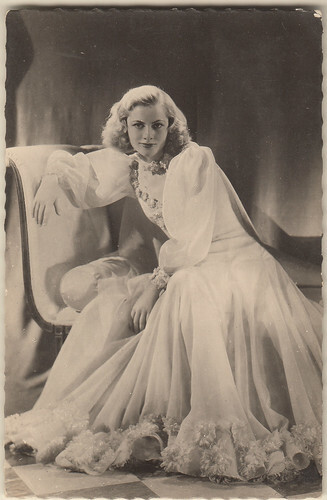
Dutch postcard by Vigevano Amsterdam, no. 3909.
Joan Fontaine’s youth
Joan Fontaine was born Joan de Havilland on the 17th of October 1917 in Tokyo, Japan, to British parents, Walter de Havilland and Lilian Ruse.
She had an older sister who would also become a famous film star: Olivia de Havilland .
In 1919, her mother relocated to the U.S.A. with her two daughters. Shortly after her divorce from Walter de Havilland had been granted, Lilian married George Fontaine in 1925.
In her teenage years, Joan went to live for some time with her father in Tokyo and then came back to the U.S.A. permanently. In the mid-1930s, she decided to follow in the footsteps of her sister Olivia, who had embarked into to an acting career.
After some stage work, Joan made her screen debut, as Joan Burfield, in No More Ladies (1935), a Joan Crawford vehicle. In 1936, she was noticed in the play 'Call It a Day' and soon got a movie contract at R.K.O. At the time, she had chosen to call herself Joan Fontaine, after her stepfather’s surname.
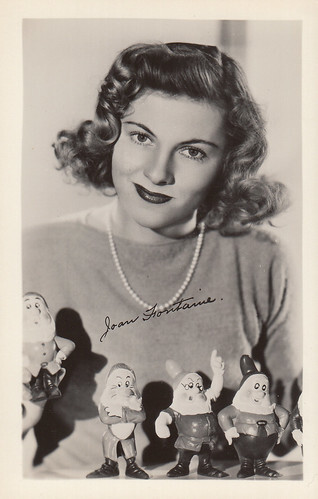
American postcard. Joan Fontaine posing with several of the seven dwarfs from the famous Walt Disney movie.
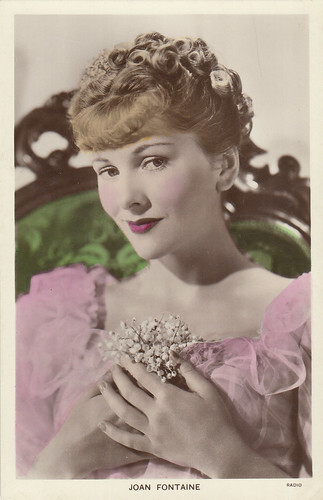
British postcard in the Colourgraph Series, no. C317. Photo: Radio. Joan Fontaine in Gunga Din (George Stevens, 1939).
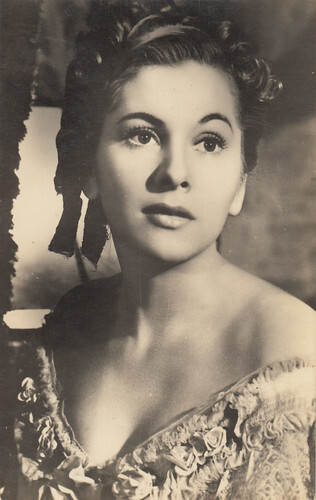
Spanish postcard by Soberanas, Barcelona, no. 21. Joan Fontaine in Rebecca (Alfred Hitchcock, 1940).
Undistinguished first Hollywood years
Her career at R.K.O. was on the whole lacklustre and she often played one-dimensional and unimpressive characters in B movies such as The Man Who Found Himself (1937), Maid’s Night Out (1938) or Blond Cheat (1938).
When she was cast in more prestigious productions, she ran out of luck.
For example, she was handed the plum assignment of appearing opposite Fred Astaire in A Damsel in Distress (1937). Faced with her lack of terpsichorean skills, R.K.O. gave her only one dancing scene with Astaire but the results were so-so. Audiences and critics came to the conclusion that she was no Ginger Rogers and the movie did nothing to boost her career.
Later, she was sixth-billed in the popular adventure film Gunga Din (1939) but, as Douglas Fairbanks Jr. ’s rather bland love interest, she didn’t have much more to do than look pretty.
After R.K.O. had not renewed her contract, she went to play Peggy, the most unassuming of the female protagonists of George Cukor’s The Women (1939) who, in the opening credits, is symbolised by a lamb. Anyway, the director was very pleased by the way she handled her part, with naturalness and sensitivity.
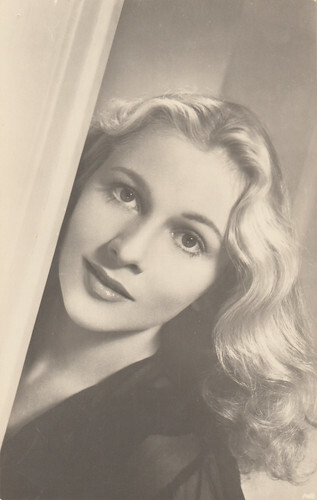
Spanish postcard by Soberanas, no. 718.
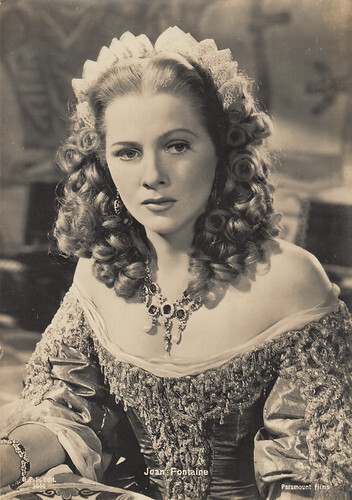
Italian postcard by B.F.F., Firenze, no. 2044. Photo: Paramount Films. Joan Fontaine in Frenchman’s Creek (Mitchell Leisen, 1944).
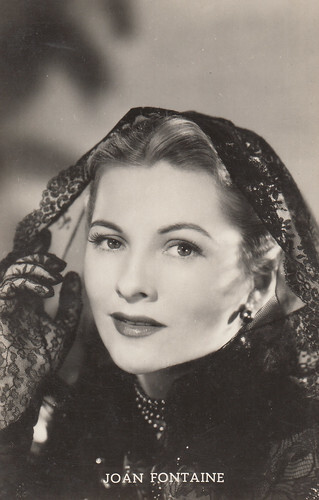
Dutch postcard by Van Leers’ Fotodrukindustrie, Amsterdam, no. 1250.
Rebecca
In 1938, David O’Selznick bought the movie rights to Daphné du Maurier’s novel 'Rebecca' and started a search to find the perfect actress to play the leading role. Many female performers were considered and tested. After some time, the selection was narrowed to five contenders: Vivien Leigh , Loretta Young, Margaret Sullavan , Anne Baxter and Joan Fontaine, who were subjected to further extensive screen tests.
Selznick soon ruled out Vivien Leigh , who didn’t project enough innocence and who came out as too cunning and flirtatious. He also rejected Young, who looked too glamourous, had a too distinctive American accent and whose acting was deemed unconvincing.
Sullavan managed to achieve an interesting level of emotional intensity but failed to convey fragility and was found too mature to play an inexperienced ingenue in love with an older man. Selznick feared that she would make a too-confident second Mrs de Winter, which wasn’t what he had envisioned for his heroine.
Baxter, who was only 16 years old at the time, was very good and made a strong impression but she looked too young for the part. Although he had some reservations about her acting, Selznick thought that Joan Fontaine could provide the character with appropriate qualities in terms of appearance and personality: she was good-looking but not breathtakingly beautiful and projected the right amount of shyness, awkwardness and vulnerability.
At the end of August 1939, he decided to give her the much-coveted leading role in Rebecca. During filming, director Alfred Hitchcock , who had not been too keen on Selznick’s choice in the first place, did his best to coax Joan into giving a top-notch performance and succeeded beyond all expectations. When Rebecca was released in 1940, she was considered perfect for the role, was nominated for an Oscar (she lost to Ginger Rogers ) and became a star.
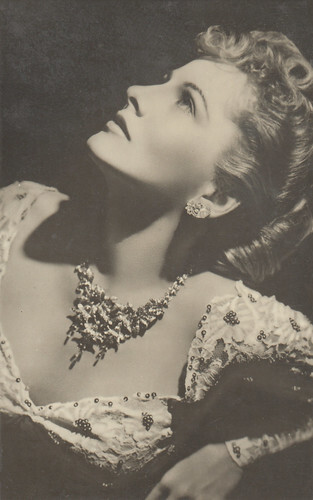
Spanish postcard by Soberanas, no. 372.
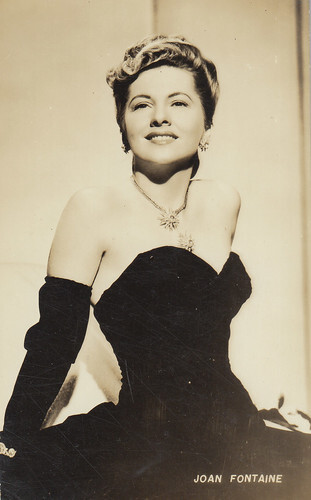
Portuguese postcard by Ediçao Trevo, no. 1969-P. Joan Fontaine in The Affairs of Susan (William A. Seiter, 1945).
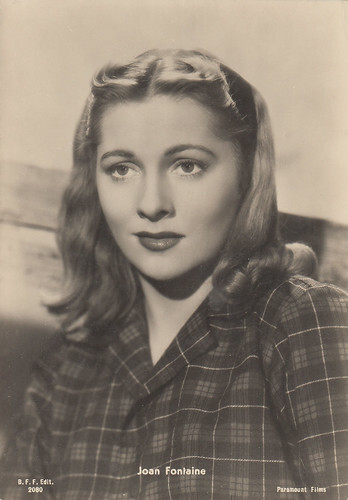
Italian postcard by B.F.F., Firenze, no. 2080. Photo: Paramount Films. Joan Fontaine in The Affairs of Susan (William A. Seiter, 1945).
Brilliant years
The forties were Joan Fontaine’s most brilliant decade. She was again directed by Hitchcock in Suspicion (1941), which earned her a Best Actress Oscar.
After a patriotic romance set in war-torn England, This Above All (1942), opposite Tyrone Power , she played touching heroines in The Constant Nymph (1943) and Jane Eyre (1944).
She then looked ravishing in the period costumes of the big-budgeted Frenchman’s Creek (1944). She was a tenement housewife in From This Day Forward (1946) and an evil poisoner in Ivy (1947).
She co-starred with Bing Crosby in the box-office hit The Emperor’s Waltz (1948) and with Burt Lancaster in the Film Noir Kiss the Blood Off My Hands (1948). Letter from an Unknown Woman (1948), directed by Max Ophuls, failed to attract audiences but has since become a classic. She also had a welcome change of pace in two comedies: The Affairs of Susan (1945) and You Gotta Stay Happy (1948).
She began the fifties by playing a scheming and manipulative social climber in Born to be Bad (1950). Next came the lush September Affair (1950), which was about a doomed love affair between a concert pianist and an unhappily married man. Audiences who were fond of romantic dramas were delighted by this movie, which was partly filmed on the enchanted island of Capri and other beautiful Italian settings.
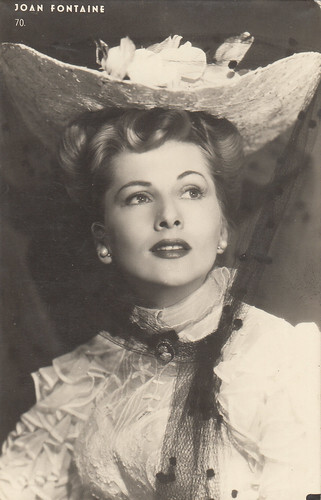
Spanish postcard, no. 70. Joan Fontaine in Ivy (Sam Wood, 1947).
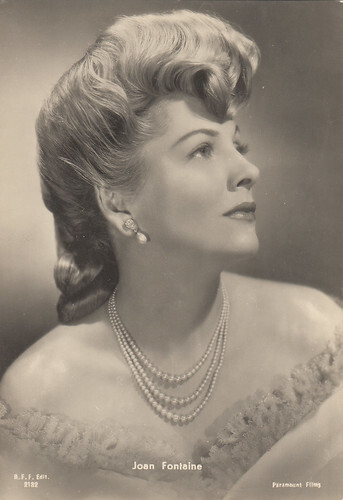
Italian postcard by B.F.F. Edit., no. 2132. Photo: Paramount Films. Joan Fontaine in The Emperor’s Waltz (Billy Wilder, 1948).
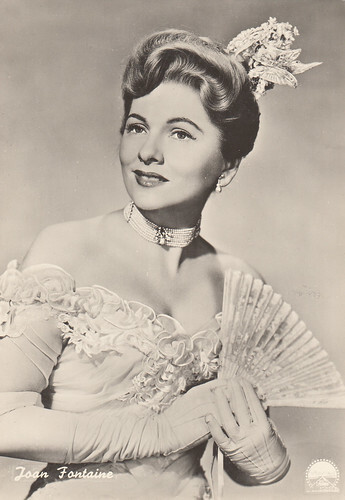
Italian postcard by Bromofoto, Milano, no. 625. Photo: Paramount. Joan Fontaine in The Emperor’s Waltz (Billy Wilder, 1948).
Up and downs
At the beginning of the 1950s, her career went into decline. Darling, How Could You (1951) and Something to Live for (1952) were not very well-received. Decameron Nights (1953) was a tame and unsuccessful attempt to adapt 'Boccaccio' and Flight to Tangier (1953) was a low-caliber programmer.
She had a rather pallid role as Rowena in Ivanhoe (1952) and played second fiddle to Bob Hope in Casanova’s Big Night (1954), which was not one of his best vehicles. She also found it most unpleasant to work with the temperamental Mario Lanza in Serenade (1956). Amidst those unrewarding parts, she gave a good performance as a distant and career-oriented wife, whose husband leads a double life, in The Bigamist (1953), an interesting picture about bigamy directed by Ida Lupino .
After being featured in Fritz Lang ’s last Hollywood movie, Beyond a Reasonable Doubt (1956), she signed to join the star-studded cast of the controversial Island in the Sun (1957), which dealt with interracial love themes. On a fictitious West-Indian island, wealthy Mavis Norman (Joan) and handsome labour organiser David Boyeur ( Harry Belafonte ) are attracted to each other but, in the end, their 'romance' is not consummated and Mavis will leave the island alone. The movie also focused on love affairs between Dorothy Dandridge and John Justin and between Stephen Boyd and Joan Collins , who is mistakingly led to believe that she‘s of mixed race. Despite several negative reactions in the Southern part of the U.S.A., Island in the Sun was a big commercial success.
She then was a spinster who awakens to love in Until They Sail (1957) and Rossano Brazzi ’s patient and understanding wife in A Certain Smile (1958), adapted from a novel by Françoise Sagan, who deeply disliked the Hollywood treatment of her book. Maybe the most satisfying feature of this movie was its theme song by Johnny Mathis.
It was followed by the popular Science-Fiction film Voyage to the Bottom of the Sea (1961), in which she played a scientist. Tender Is The Night (1962) was dismissed by most critics but Joan received good reviews for her role as Baby Warren, the heroine’s sister. Her cinematographic career ended in England with the Hammer Horror movie The Witches (1965).
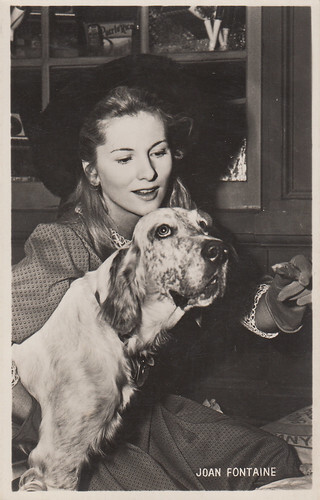
Vintage postcard no. 232. Joan Fontaine in Letter from an Unknown Woman (Max Ophüls, 1948).
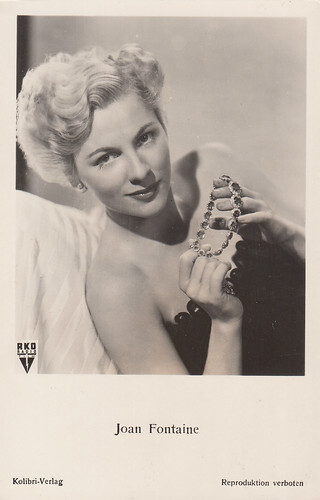
German postcard by Kolibri Verlag. Photo: RKO Radio Pictures. Joan Fontaine in Born to be Bad (Nicholas Ray, 1950).
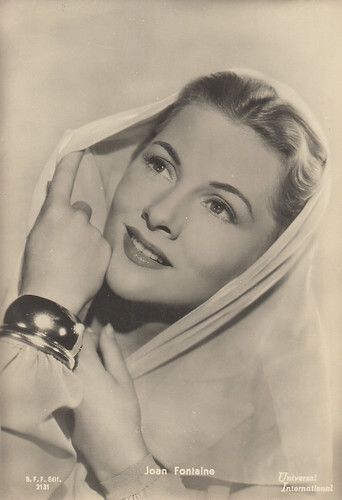
Italian postcard by B.F.F., Firenze, no. 2131. Photo: Universal International.
On stage and on television
In June 1954, she replaced Deborah Kerr in the play 'Tea and Sympathy' on Broadway. She successfully continued with it until February 1955. She later made other occasional stage appearances over the years.
From 1953 to 1994, she also worked now and then for television and got an Emmy Award nomination for Ryan’s Hope in 1980. Her last acting part was as a Czech King’s beloved grandmother in the TV movie Good King Wenceslas (1994).
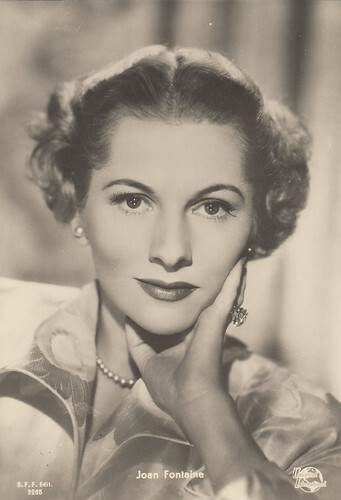
Italian postcard by B.F.F., Firenze, no. 2265. Photo: Universal International.
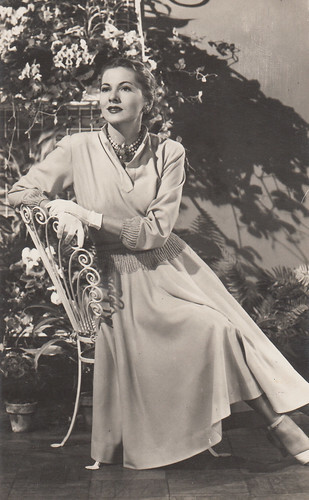
Spanish postcard, no. 1067.
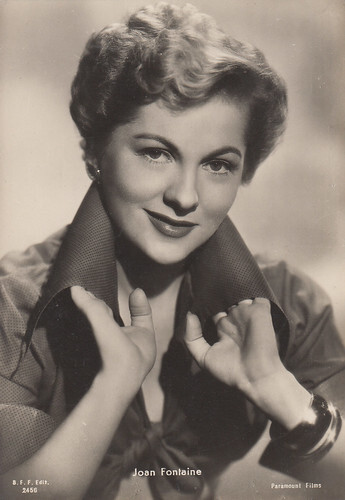
Italian postcard by B.F.F., Firenze, no. 2456. Photo: Paramount Films.
Her private life
Joan Fontaine married and divorced four times. Her husbands were actor Brian Aherne (1939-1945), producer William Dozier (1946-1951), producer Collier Young (1952-1961) and golf editor of Sports Illustrated Alfred Wright Jr. (1964-1969).
In 1948, she had one daughter, Deborah, from Dozier. In 1951, she brought back Martita, a young Peruvian child, from South America but never formally adopted her.
Deborah and Martita’s relationship with Joan had been at times rocky.
Deborah said: "When she was home and she wanted to be a mother, she was an absolute joy to be around. She could be the most enthusiastic and exuberant person, ever. But then, she’d turned and we were terrified of her. Maybe she was bipolar because you just didn’t know what you were going to get". She also revealed that she was far closer to her aunt, Olivia de Havilland than to her own mother.
Between Martita and Joan, there had been at one time a serious rift, which, after a long period of estrangement, seems to have healed later. Joan Fontaine spent the last years of her life in Carmel, in a beautiful villa overlooking the ocean, and passed away on the 15th of December 2013.
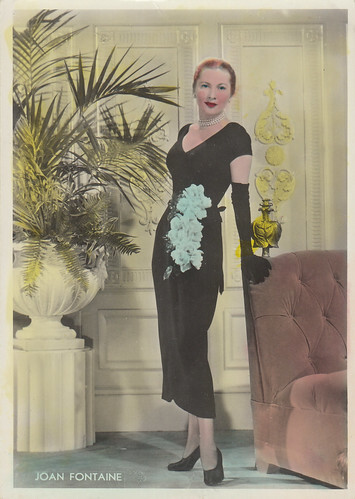
Dutch postcard by Uitgave P.F. Cladder Amsterdam, no. 49-12.
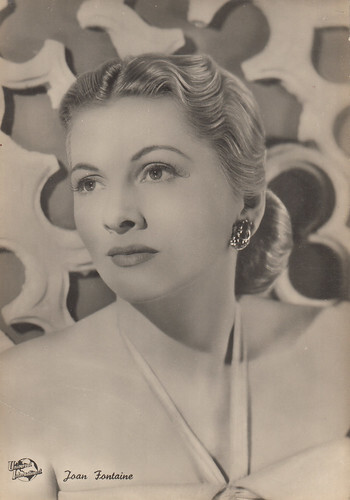
Italian postcard by Rotalfoto, Milano, no. 66. Photo: Universal International.
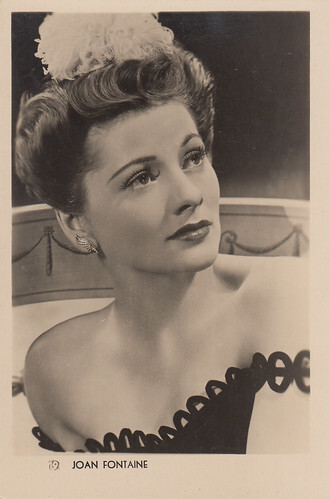
Spanish postcard, no. 19.
The famous feud
So much has been written over the years about the feud between Olivia de Havilland and Joan Fontaine. The two women had very different personalities. Deborah Dozier once said: "Joan was glib, Olivia was gracious". As years went by, the contrast intensified. Joan became more of a jet-setter and has often been termed as sophisticated, witty and brittle, whereas her older sister choose a quiet family life and was described as dignified, proper and level-headed.
It seems that, during childhood, the two sisters already didn’t get along well. Later, professional rivalry came to tax their relationship even more. In February 1941, both sisters were nominated for a Best Actress Oscar and Joan won. Olivia had to wait several years to get hers.
An event at the March 1947 Academy Award ceremony clearly showed how the relationship between the two sisters was strained: when Joan came forward to congratulate Olivia for her first Oscar, she ostensibly turned away from her without a glance. It was said that Olivia hadn’t forgotten or forgiven the remarks her sister allegedly had made in 1946 about her first husband, writer Marcus Goodrich.
Afterwards, Olivia and Joan had a hot-and-cold relationship and still occasionally saw each other. The ties between them suffered a severe blow in 1975 when their mother passed away. Joan, who was on tour at the time, accused her sister of not inviting her to the memorial service and claimed that she had to demand that the ceremony would be delayed until she could attend it. When the event finally took place, they didn’t exchange a word. At an Oscar reunion in 1979, Olivia and Joan had to be placed on separate ends of the stage.
It came as a surprise to everybody when, in a 2013 interview, Joan allegedly said that the two sisters never had a rough patch and never had a quarrel. This was in complete contradiction with statements she had made before such as, in a 1978 interview, "You can divorce your sister as well as your husbands. I don’t see Olivia and I don’t intend to". However, in 2016, Olivia set the record straight and confirmed that they were estranged at the time of Joan’s death in 2013. She described her sister as a multi-faceted person, varying from endearing to alienating, who had astigmatism in her perception of both people and situations.
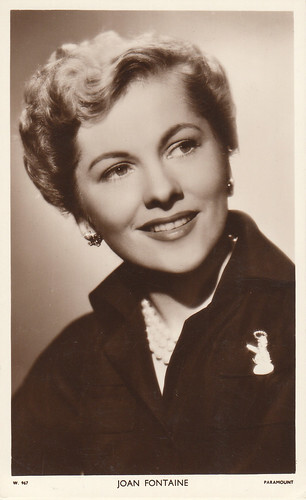
British postcard by Picturegoer, no. W 967. Photo: Paramount.
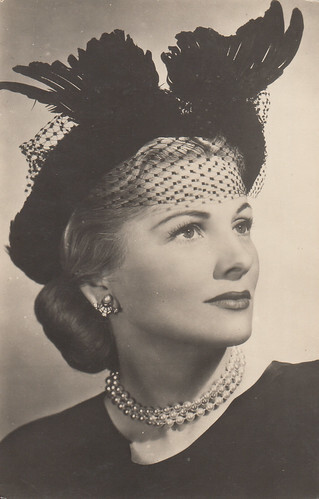
Spanish postcard, no. 43.
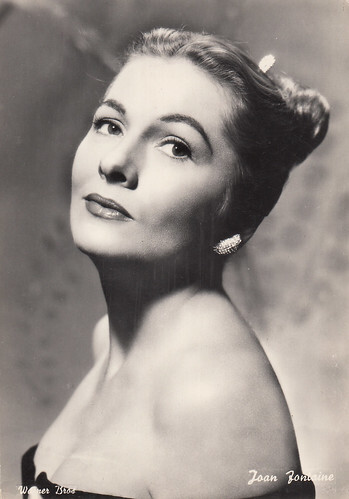
Italian postcard by Bromofoto, Milano, no. 1163. Photo: Warner Bros.
Text and postcards: Marlene Pilaete.
If she could perfectly play sweet and restrained characters in films, she was quite different in real life, as periods of estrangement from her daughters and her sister would suggest. However, Joan’s relationship with some other people seems to have been more cordial. Susan Pfeiffer, her secretary in later years, described her as 'one of the kindest, loving women I have ever met' and Police Officer Bill Cassara, who met her in 1997 and befriended her, reminisced in 2021 about 'her warm conversation and company'.

French postcard by A.N. Paris, no. 1103. Photo: RKO Films.

Italian postcard by G.B. Falci Editore, Milano, no. 21. Photo: RKO Radio.

Dutch postcard by Vigevano Amsterdam, no. 3909.
Joan Fontaine’s youth
Joan Fontaine was born Joan de Havilland on the 17th of October 1917 in Tokyo, Japan, to British parents, Walter de Havilland and Lilian Ruse.
She had an older sister who would also become a famous film star: Olivia de Havilland .
In 1919, her mother relocated to the U.S.A. with her two daughters. Shortly after her divorce from Walter de Havilland had been granted, Lilian married George Fontaine in 1925.
In her teenage years, Joan went to live for some time with her father in Tokyo and then came back to the U.S.A. permanently. In the mid-1930s, she decided to follow in the footsteps of her sister Olivia, who had embarked into to an acting career.
After some stage work, Joan made her screen debut, as Joan Burfield, in No More Ladies (1935), a Joan Crawford vehicle. In 1936, she was noticed in the play 'Call It a Day' and soon got a movie contract at R.K.O. At the time, she had chosen to call herself Joan Fontaine, after her stepfather’s surname.

American postcard. Joan Fontaine posing with several of the seven dwarfs from the famous Walt Disney movie.

British postcard in the Colourgraph Series, no. C317. Photo: Radio. Joan Fontaine in Gunga Din (George Stevens, 1939).

Spanish postcard by Soberanas, Barcelona, no. 21. Joan Fontaine in Rebecca (Alfred Hitchcock, 1940).
Undistinguished first Hollywood years
Her career at R.K.O. was on the whole lacklustre and she often played one-dimensional and unimpressive characters in B movies such as The Man Who Found Himself (1937), Maid’s Night Out (1938) or Blond Cheat (1938).
When she was cast in more prestigious productions, she ran out of luck.
For example, she was handed the plum assignment of appearing opposite Fred Astaire in A Damsel in Distress (1937). Faced with her lack of terpsichorean skills, R.K.O. gave her only one dancing scene with Astaire but the results were so-so. Audiences and critics came to the conclusion that she was no Ginger Rogers and the movie did nothing to boost her career.
Later, she was sixth-billed in the popular adventure film Gunga Din (1939) but, as Douglas Fairbanks Jr. ’s rather bland love interest, she didn’t have much more to do than look pretty.
After R.K.O. had not renewed her contract, she went to play Peggy, the most unassuming of the female protagonists of George Cukor’s The Women (1939) who, in the opening credits, is symbolised by a lamb. Anyway, the director was very pleased by the way she handled her part, with naturalness and sensitivity.

Spanish postcard by Soberanas, no. 718.

Italian postcard by B.F.F., Firenze, no. 2044. Photo: Paramount Films. Joan Fontaine in Frenchman’s Creek (Mitchell Leisen, 1944).

Dutch postcard by Van Leers’ Fotodrukindustrie, Amsterdam, no. 1250.
Rebecca
In 1938, David O’Selznick bought the movie rights to Daphné du Maurier’s novel 'Rebecca' and started a search to find the perfect actress to play the leading role. Many female performers were considered and tested. After some time, the selection was narrowed to five contenders: Vivien Leigh , Loretta Young, Margaret Sullavan , Anne Baxter and Joan Fontaine, who were subjected to further extensive screen tests.
Selznick soon ruled out Vivien Leigh , who didn’t project enough innocence and who came out as too cunning and flirtatious. He also rejected Young, who looked too glamourous, had a too distinctive American accent and whose acting was deemed unconvincing.
Sullavan managed to achieve an interesting level of emotional intensity but failed to convey fragility and was found too mature to play an inexperienced ingenue in love with an older man. Selznick feared that she would make a too-confident second Mrs de Winter, which wasn’t what he had envisioned for his heroine.
Baxter, who was only 16 years old at the time, was very good and made a strong impression but she looked too young for the part. Although he had some reservations about her acting, Selznick thought that Joan Fontaine could provide the character with appropriate qualities in terms of appearance and personality: she was good-looking but not breathtakingly beautiful and projected the right amount of shyness, awkwardness and vulnerability.
At the end of August 1939, he decided to give her the much-coveted leading role in Rebecca. During filming, director Alfred Hitchcock , who had not been too keen on Selznick’s choice in the first place, did his best to coax Joan into giving a top-notch performance and succeeded beyond all expectations. When Rebecca was released in 1940, she was considered perfect for the role, was nominated for an Oscar (she lost to Ginger Rogers ) and became a star.

Spanish postcard by Soberanas, no. 372.

Portuguese postcard by Ediçao Trevo, no. 1969-P. Joan Fontaine in The Affairs of Susan (William A. Seiter, 1945).

Italian postcard by B.F.F., Firenze, no. 2080. Photo: Paramount Films. Joan Fontaine in The Affairs of Susan (William A. Seiter, 1945).
Brilliant years
The forties were Joan Fontaine’s most brilliant decade. She was again directed by Hitchcock in Suspicion (1941), which earned her a Best Actress Oscar.
After a patriotic romance set in war-torn England, This Above All (1942), opposite Tyrone Power , she played touching heroines in The Constant Nymph (1943) and Jane Eyre (1944).
She then looked ravishing in the period costumes of the big-budgeted Frenchman’s Creek (1944). She was a tenement housewife in From This Day Forward (1946) and an evil poisoner in Ivy (1947).
She co-starred with Bing Crosby in the box-office hit The Emperor’s Waltz (1948) and with Burt Lancaster in the Film Noir Kiss the Blood Off My Hands (1948). Letter from an Unknown Woman (1948), directed by Max Ophuls, failed to attract audiences but has since become a classic. She also had a welcome change of pace in two comedies: The Affairs of Susan (1945) and You Gotta Stay Happy (1948).
She began the fifties by playing a scheming and manipulative social climber in Born to be Bad (1950). Next came the lush September Affair (1950), which was about a doomed love affair between a concert pianist and an unhappily married man. Audiences who were fond of romantic dramas were delighted by this movie, which was partly filmed on the enchanted island of Capri and other beautiful Italian settings.

Spanish postcard, no. 70. Joan Fontaine in Ivy (Sam Wood, 1947).

Italian postcard by B.F.F. Edit., no. 2132. Photo: Paramount Films. Joan Fontaine in The Emperor’s Waltz (Billy Wilder, 1948).

Italian postcard by Bromofoto, Milano, no. 625. Photo: Paramount. Joan Fontaine in The Emperor’s Waltz (Billy Wilder, 1948).
Up and downs
At the beginning of the 1950s, her career went into decline. Darling, How Could You (1951) and Something to Live for (1952) were not very well-received. Decameron Nights (1953) was a tame and unsuccessful attempt to adapt 'Boccaccio' and Flight to Tangier (1953) was a low-caliber programmer.
She had a rather pallid role as Rowena in Ivanhoe (1952) and played second fiddle to Bob Hope in Casanova’s Big Night (1954), which was not one of his best vehicles. She also found it most unpleasant to work with the temperamental Mario Lanza in Serenade (1956). Amidst those unrewarding parts, she gave a good performance as a distant and career-oriented wife, whose husband leads a double life, in The Bigamist (1953), an interesting picture about bigamy directed by Ida Lupino .
After being featured in Fritz Lang ’s last Hollywood movie, Beyond a Reasonable Doubt (1956), she signed to join the star-studded cast of the controversial Island in the Sun (1957), which dealt with interracial love themes. On a fictitious West-Indian island, wealthy Mavis Norman (Joan) and handsome labour organiser David Boyeur ( Harry Belafonte ) are attracted to each other but, in the end, their 'romance' is not consummated and Mavis will leave the island alone. The movie also focused on love affairs between Dorothy Dandridge and John Justin and between Stephen Boyd and Joan Collins , who is mistakingly led to believe that she‘s of mixed race. Despite several negative reactions in the Southern part of the U.S.A., Island in the Sun was a big commercial success.
She then was a spinster who awakens to love in Until They Sail (1957) and Rossano Brazzi ’s patient and understanding wife in A Certain Smile (1958), adapted from a novel by Françoise Sagan, who deeply disliked the Hollywood treatment of her book. Maybe the most satisfying feature of this movie was its theme song by Johnny Mathis.
It was followed by the popular Science-Fiction film Voyage to the Bottom of the Sea (1961), in which she played a scientist. Tender Is The Night (1962) was dismissed by most critics but Joan received good reviews for her role as Baby Warren, the heroine’s sister. Her cinematographic career ended in England with the Hammer Horror movie The Witches (1965).

Vintage postcard no. 232. Joan Fontaine in Letter from an Unknown Woman (Max Ophüls, 1948).

German postcard by Kolibri Verlag. Photo: RKO Radio Pictures. Joan Fontaine in Born to be Bad (Nicholas Ray, 1950).

Italian postcard by B.F.F., Firenze, no. 2131. Photo: Universal International.
On stage and on television
In June 1954, she replaced Deborah Kerr in the play 'Tea and Sympathy' on Broadway. She successfully continued with it until February 1955. She later made other occasional stage appearances over the years.
From 1953 to 1994, she also worked now and then for television and got an Emmy Award nomination for Ryan’s Hope in 1980. Her last acting part was as a Czech King’s beloved grandmother in the TV movie Good King Wenceslas (1994).

Italian postcard by B.F.F., Firenze, no. 2265. Photo: Universal International.

Spanish postcard, no. 1067.

Italian postcard by B.F.F., Firenze, no. 2456. Photo: Paramount Films.
Her private life
Joan Fontaine married and divorced four times. Her husbands were actor Brian Aherne (1939-1945), producer William Dozier (1946-1951), producer Collier Young (1952-1961) and golf editor of Sports Illustrated Alfred Wright Jr. (1964-1969).
In 1948, she had one daughter, Deborah, from Dozier. In 1951, she brought back Martita, a young Peruvian child, from South America but never formally adopted her.
Deborah and Martita’s relationship with Joan had been at times rocky.
Deborah said: "When she was home and she wanted to be a mother, she was an absolute joy to be around. She could be the most enthusiastic and exuberant person, ever. But then, she’d turned and we were terrified of her. Maybe she was bipolar because you just didn’t know what you were going to get". She also revealed that she was far closer to her aunt, Olivia de Havilland than to her own mother.
Between Martita and Joan, there had been at one time a serious rift, which, after a long period of estrangement, seems to have healed later. Joan Fontaine spent the last years of her life in Carmel, in a beautiful villa overlooking the ocean, and passed away on the 15th of December 2013.

Dutch postcard by Uitgave P.F. Cladder Amsterdam, no. 49-12.

Italian postcard by Rotalfoto, Milano, no. 66. Photo: Universal International.

Spanish postcard, no. 19.
The famous feud
So much has been written over the years about the feud between Olivia de Havilland and Joan Fontaine. The two women had very different personalities. Deborah Dozier once said: "Joan was glib, Olivia was gracious". As years went by, the contrast intensified. Joan became more of a jet-setter and has often been termed as sophisticated, witty and brittle, whereas her older sister choose a quiet family life and was described as dignified, proper and level-headed.
It seems that, during childhood, the two sisters already didn’t get along well. Later, professional rivalry came to tax their relationship even more. In February 1941, both sisters were nominated for a Best Actress Oscar and Joan won. Olivia had to wait several years to get hers.
An event at the March 1947 Academy Award ceremony clearly showed how the relationship between the two sisters was strained: when Joan came forward to congratulate Olivia for her first Oscar, she ostensibly turned away from her without a glance. It was said that Olivia hadn’t forgotten or forgiven the remarks her sister allegedly had made in 1946 about her first husband, writer Marcus Goodrich.
Afterwards, Olivia and Joan had a hot-and-cold relationship and still occasionally saw each other. The ties between them suffered a severe blow in 1975 when their mother passed away. Joan, who was on tour at the time, accused her sister of not inviting her to the memorial service and claimed that she had to demand that the ceremony would be delayed until she could attend it. When the event finally took place, they didn’t exchange a word. At an Oscar reunion in 1979, Olivia and Joan had to be placed on separate ends of the stage.
It came as a surprise to everybody when, in a 2013 interview, Joan allegedly said that the two sisters never had a rough patch and never had a quarrel. This was in complete contradiction with statements she had made before such as, in a 1978 interview, "You can divorce your sister as well as your husbands. I don’t see Olivia and I don’t intend to". However, in 2016, Olivia set the record straight and confirmed that they were estranged at the time of Joan’s death in 2013. She described her sister as a multi-faceted person, varying from endearing to alienating, who had astigmatism in her perception of both people and situations.

British postcard by Picturegoer, no. W 967. Photo: Paramount.

Spanish postcard, no. 43.

Italian postcard by Bromofoto, Milano, no. 1163. Photo: Warner Bros.
Text and postcards: Marlene Pilaete.
Published on July 29, 2023 22:00
July 28, 2023
Caricatures by Girus
The Italian artist Giuseppe Russo (1888-1960), better known as Girus, was a caricaturist by passion. His subjects were show business and politics and in the late 1910s and early 1920s he made a series of caricatures of actors for the postcard company CCM (Cesare Capello, Milano). Capello's firm was founded in 1908, used a logo with the letters CCM between 1919 and 1927, and changed its name in 1930 to Cecami.
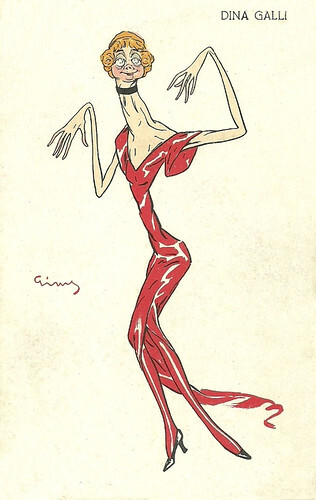
Italian postcard by CCM (Cesare Capello, Milano). Caricature by Girus.
Dina Galli (1877-1951) was a classic Italian comedienne who also performed in Italian silent and sound cinema.
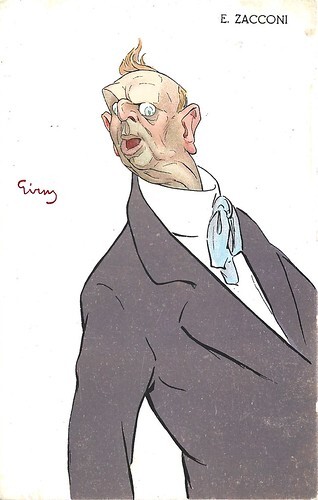
Italian postcard by CCM (Cesare Capello, Milano). Caricature by Girus.
Ermete Zacconi (1857-1948) was a monstre sacré of the Italian theater. He also acted in various Italian silent and sound films.
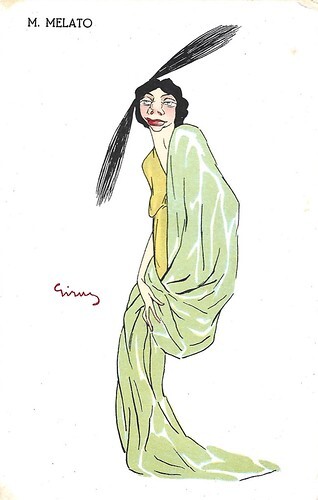
Italian postcard by CCM (Cesare Capello, Milano). Caricature by Girus.
Italian actress Maria Melato (1885-1950) appeared in the theatre, on the radio and in the cinema. Her films included Ritorno/Return (1914), Anna Karenina (1917) and Il volo degli aironi/The Flight of the Herons (1920). Unfortunately, all her films are considered lost.
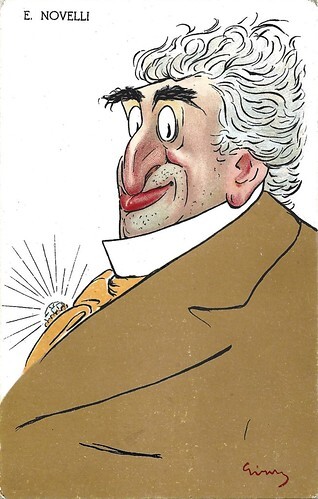
Italian postcard by CCM (Cesare Capello, Milano). Caricature by Girus.
Italian actor Ermete Novelli (1851-1919) was a legendary monstre sacré of the theatre. In the 1910s he appeared in films by Film d'Arte Italiana, Ambrosio and Raggio Film.
A caricaturist by passion
Giuseppe Russo (Girus) was born in Catanzaro, Italy, in 1888. Although trained as a dental technician, he was also a caricaturist by passion.
One day he asked Pio Vanzi - humourist and editor-in-chief of the Roman monthly Noi e il mondo by Lucio d'Ambra - if he could caricature him. He was thus discovered and brought to the capital, where he was successful with subjects related to current affairs in show business and politics.
He collaborated with various publications, also arriving at L'asino, Il becco giallo, the Milanese Guerin Meschino (at least from 1924 to 1939), and Il Travaso (until 1943).
He also tried his hand, with pleasing results, at comics, drawing characters and stories for the Corriere dei Piccoli between 1933 and 1935, such as the serial stories 'Il tesoro dei Caracai', 'Il Castello dei misteri' and 'Le fatiche d'Ercole'.
He collaborated with Guglielmo Giannini's new political and satirical weekly L'Uomo Qualunque, from the first issue was published in the liberated capital on 27 December 1944. Giuseppe Russo died in 1960.
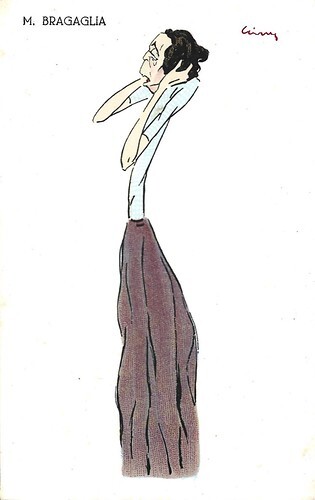
Italian postcard by CCM. Caricature by Girus.
Marinella Bragaglia (1882-1918) was an Italian theatre actress.
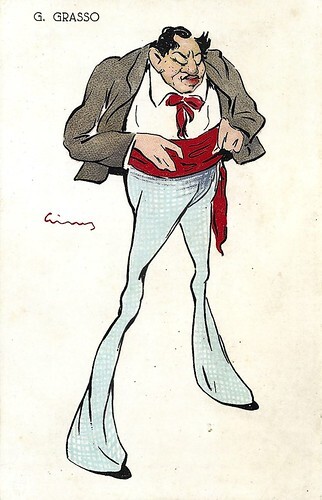
Italian postcard by CCM. Caricature by Girus.
Giovanni Grasso (1873-1930) was an Italian stage and screen actor. While he goes as the best Sicilian tragic actor and one of the best in Italy, he also had a limited but very important career in Italian silent cinema.
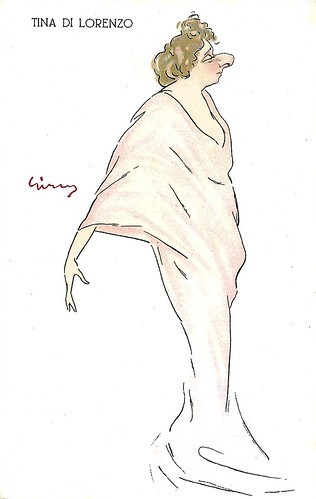
Italian postcard by CCM. Caricature by Girus.
Tina Di Lorenzo (1872-1930) was one of the 'grandes dames' of the Italian stage during the early twentieth century, nicknamed "Angelicata" and "La encantadora". In 1915 she also acted in two or three films. In 1901 she married reputed stage actor Armando Falconi , who would have a second career in Italian sound cinema.
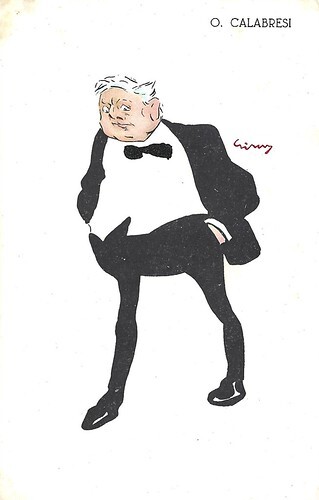
Italian postcard by CCM. Caricature by Girus.
Oreste Calabresi (1857-1915) was considered one of the most important Italian theatrical actors in business between the nineteenth and twentieth centuries. He also acted in two films.
Sources: Silvia Cappellazzo (Esposizioni d’Arte umoristica e di Caricatura tra fine Ottocento e primo Novecento in Italia, Università Ca'Foscari, 2013), Fondazione Franco Fossati (Italian), and Misterkappa. Thanks to Luigi F. Bona (Chair Fondazione Franco Fossati).

Italian postcard by CCM (Cesare Capello, Milano). Caricature by Girus.
Dina Galli (1877-1951) was a classic Italian comedienne who also performed in Italian silent and sound cinema.

Italian postcard by CCM (Cesare Capello, Milano). Caricature by Girus.
Ermete Zacconi (1857-1948) was a monstre sacré of the Italian theater. He also acted in various Italian silent and sound films.

Italian postcard by CCM (Cesare Capello, Milano). Caricature by Girus.
Italian actress Maria Melato (1885-1950) appeared in the theatre, on the radio and in the cinema. Her films included Ritorno/Return (1914), Anna Karenina (1917) and Il volo degli aironi/The Flight of the Herons (1920). Unfortunately, all her films are considered lost.

Italian postcard by CCM (Cesare Capello, Milano). Caricature by Girus.
Italian actor Ermete Novelli (1851-1919) was a legendary monstre sacré of the theatre. In the 1910s he appeared in films by Film d'Arte Italiana, Ambrosio and Raggio Film.
A caricaturist by passion
Giuseppe Russo (Girus) was born in Catanzaro, Italy, in 1888. Although trained as a dental technician, he was also a caricaturist by passion.
One day he asked Pio Vanzi - humourist and editor-in-chief of the Roman monthly Noi e il mondo by Lucio d'Ambra - if he could caricature him. He was thus discovered and brought to the capital, where he was successful with subjects related to current affairs in show business and politics.
He collaborated with various publications, also arriving at L'asino, Il becco giallo, the Milanese Guerin Meschino (at least from 1924 to 1939), and Il Travaso (until 1943).
He also tried his hand, with pleasing results, at comics, drawing characters and stories for the Corriere dei Piccoli between 1933 and 1935, such as the serial stories 'Il tesoro dei Caracai', 'Il Castello dei misteri' and 'Le fatiche d'Ercole'.
He collaborated with Guglielmo Giannini's new political and satirical weekly L'Uomo Qualunque, from the first issue was published in the liberated capital on 27 December 1944. Giuseppe Russo died in 1960.

Italian postcard by CCM. Caricature by Girus.
Marinella Bragaglia (1882-1918) was an Italian theatre actress.

Italian postcard by CCM. Caricature by Girus.
Giovanni Grasso (1873-1930) was an Italian stage and screen actor. While he goes as the best Sicilian tragic actor and one of the best in Italy, he also had a limited but very important career in Italian silent cinema.

Italian postcard by CCM. Caricature by Girus.
Tina Di Lorenzo (1872-1930) was one of the 'grandes dames' of the Italian stage during the early twentieth century, nicknamed "Angelicata" and "La encantadora". In 1915 she also acted in two or three films. In 1901 she married reputed stage actor Armando Falconi , who would have a second career in Italian sound cinema.

Italian postcard by CCM. Caricature by Girus.
Oreste Calabresi (1857-1915) was considered one of the most important Italian theatrical actors in business between the nineteenth and twentieth centuries. He also acted in two films.
Sources: Silvia Cappellazzo (Esposizioni d’Arte umoristica e di Caricatura tra fine Ottocento e primo Novecento in Italia, Università Ca'Foscari, 2013), Fondazione Franco Fossati (Italian), and Misterkappa. Thanks to Luigi F. Bona (Chair Fondazione Franco Fossati).
Published on July 28, 2023 22:00
July 27, 2023
The Marx Brothers
The Marx Brothers was the name for a group of American-Jewish comedians from the first half of the 20th century who were actually brothers. Their career started in theatre, but they became world-famous through their films. They are known for their wild, anarchic and often surrealist humour. Their jokes consist of slapstick, but also puns and intelligent dialogue. With their rebellious jokes, they were the forerunners of generations of anti-sentimental comedians. Five brothers together formed The Marx Brothers, even though the five of them never actually performed at the same time: Harpo, Chico, Groucho, Gummo and Zeppo.
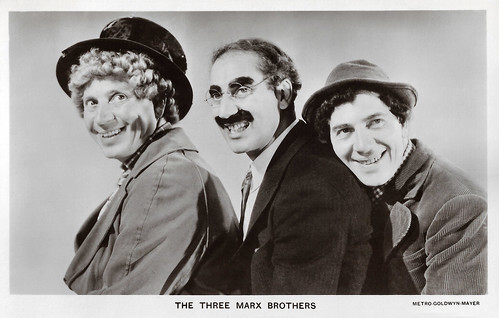
British postcard in the Picturegoer Series, London, no. 1219. Photo: Metro-Goldwyn-Mayer.

French postcard by Editions La Malibran, Paris / Saint-Dié, no. CA 4. Photo: The Marx Brothers in A Night at the Opera (Sam Wood, 1935). Caption: Harpo - Groucho - Chico Marx.
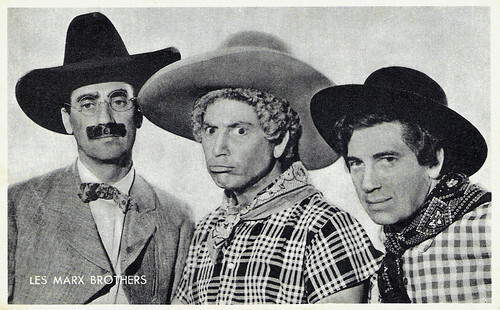
Belgian collectors card by Kwatta, Bois-d'Haine, no. C. 169 (in the series C. 99 - 196). Photo: M.G.M. The Marx Brothers in Go West (Edward Buzzell, 1940).
Chico, Harpo, Groucho, Gummo & Zeppo
The eldest Marx brother, Chico (1887-1961) was born Leonard Marx. Manfred was actually the eldest, but he died as a child. Chico was the one who decided to make musical comedies with his other brothers. At the time, he had learnt an Italian accent to convince any anti-Semites in the neighbourhood that he was Italian and not a Jew. This accent, along with his talent as a piano player, became one of his trademarks. In the films, he usually fulfilled the role of a sly and shady con man, the confidant of Harpo, a confident pianist and the sceptical assistant of Groucho.
Harpo (1888-1964) was born Adolph Marx and changed his name to Arthur in WWI because he found the name too German. As an actor, Harpo played the role of a mute, who never speaks but expresses himself through sign language, whistling and using his horn. Like a cross between a child and a wild beast, he sets everything in motion, harassing everyone, pulling the most peculiar things out of his coat (such as a candle burning on two sides, a coiled rope, a pin-up poster, etc.), and chasing women with his horn. His pseudonym "Harpo" was derived from the fact that he played the harp, for which there was a musical interlude in almost every film.
Groucho (1890-1977) was born Julius Henry Marx. His trademarks were his grin, thick cigar, waddling gait and sarcastic remarks, insults and puns. In the films, he was constantly trying to get money or women, talking everyone under the table with his witty and intelligent remarks. He was also a singer and some of his songs have become classics, such as 'Lydia the Tattooed Lady'.
Gummo (1892-1977) was born Milton Marx and was the least-known Marx brother. He was the one who first performed with Groucho, but before the big Broadway success came he had stopped acting. For years, he was his brother's manager.
Zeppo (1901-1979) was born Herbert Marx and was the youngest of the Marx Brothers. He took over the role of Gummo when the latter quit. Zeppo was the romantic declarer. Though he could take on more versatile roles, he was typecast as the most serious of the four.
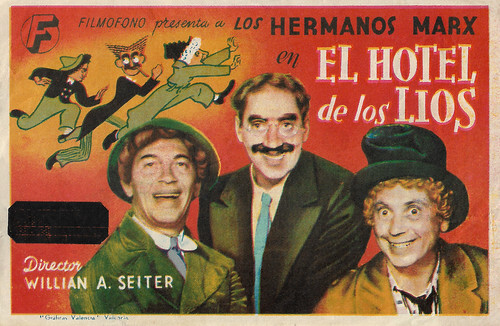
Spanish collectors card by Graficas Valencia, Valencia. Photo: Filmofono. The Marx Brothers in Room Service (William A. Seiter, 1938). The Spanish title was El Hotel de los Lios.
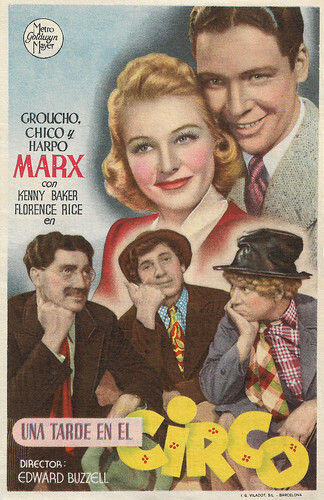
Spanish collectors card by I.G. Viladot, Barcelona. Photo: Metro-Goldwyn-Mayer. The Marx Brothers in At the Circus (Edward Buzzell, 1939) with Kenny Baker and Florence Rice.
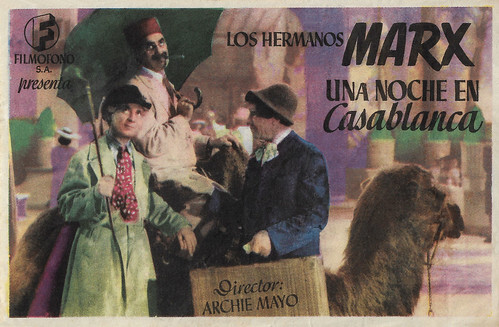
Spanish collectors card by Imp. Suso, Burgos. Photo: Filmofono. The Marx Brothers in A Night in Casablanca (Archie Mayo, 1946).
I'll say she is
The Marx Brothers were the five surviving sons of Sam and Minnie Marx. The family lived in Yorkville on New York's Upper East Side, a neighbourhood sandwiched between the Irish-German and Italian quarters.
Their career already began at the beginning of the century in vaudeville shows, with which their maternal uncle, Al Shean, had already been successful. Groucho Marx was the first to embark on a career on stage, but initially with very little success.
Their mother and sister also appeared on stage with their sons at times. However, the focus soon shifted from music and singing with humorous segues to comedy with musical interludes. The different roles of musicians and comedians crystallised relatively early.
While Chico developed the stereotype of the womaniser with an Italian accent who was always chasing the chicks, Groucho dropped his accent as a German during the First World War due to a lack of popularity. Harpo remained speechless on stage, as he had the greatest successes playing his jokes as a mime in a red or, in films, blond curly wig, or playing his grandmother's old harp.
A classroom sketch in which Groucho tried to teach his brothers evolved into the comedy show 'I'll Say She Is' which became their first success on Bradway and in England. This was followed by two more Broadway hits: 'The Cocoanuts' and 'Animal Crackers'. The Marx Brothers' shows became popular at a time when Hollywood was experiencing the transition from silent film to talkies. The brothers signed a contract with Paramount Pictures and thus launched their film career.
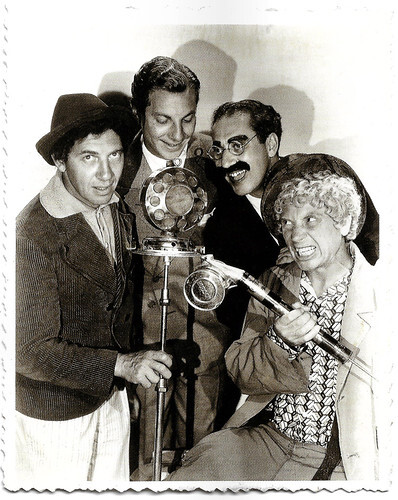
American postcard from the Marx Brothers Postcard Book by Green Wood, no. 1992. Caption: The Four Marx Brothers, Chico, Zeppo, Groucho and Harpo.
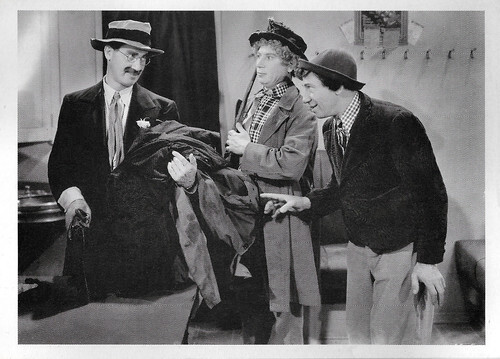
Canadian postcard by Canadian Postcard, no. A-57. Caption: Marx Brothers, Groucho, Harpo and Chico.
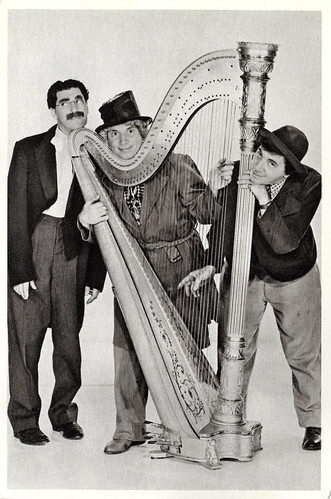
French postcard by Editions La Malibran, Paris / Saint-Dié, no. CA 5. Caption: Groucho - Harpo - Chico Marx.
Duck soup
The last two Broadway shows of The Marx Brothers became their first films, The Cocoanuts (Robert Florey, 1929) and Animal Crackers (Victor Heerman, 1930). Their next film was Monkey Business (Norman Z. McLeod, 1931). Between 1932 and 1933, a total of 26 episodes of the radio show 'Flywheel, Shyster & Flywheel' were made, with Groucho voicing the lawyer Waldorf T. Flywheel and Chico voicing his sidekick Emmanuel Ravelli. The first three episodes were broadcast under the title 'Beagle, Shyster & Beagle'. The title was then changed after a New York lawyer named "Beagle" threatened to sue. Some of the dialogue from the radio broadcasts was later used in the Marx Brothers films.
Their most successful film of the early period was Horse Feathers (Norman Z. McLeod, 1932), a satire on the American college system. But Duck Soup (Leo McCarey, 1933), generally considered their masterpiece, had much less success. It marked their break with Paramount. Zeppo, who always played serious roles, stopped making films after this. The Marx Brothers' first five films are generally considered their best, expressing their surrealist and anarchic humour in its purest form.
The three remaining brothers moved to Metro-Goldwyn-Mayer and changed the formula of their subsequent films. Their remaining films were given romantic plots and serious musical interludes, often intended as resting points between the often hilarious comic sketches. In A Night at the Opera (Sam Wood, 1935), a satire on the opera world, the brothers help two young singers in love. The film was very successful and was followed by the equally popular A Day at the Races (Sam Wood, 1937), where they kicked up a fuss at a race track. Several less memorable films followed until 1941. After the war, two more films A Night in Casablanca (Archie Mayo, 1946) and Love Happy (David Miller, 1949) followed to pay off Chico's gambling debts.
This was followed by the mediocre film The Story of Mankind (Irwin Allen, 1957), and a television special The Incredible Jewel Robbery (1959). These productions were already interludes, while each brother had already picked up a career of his own. Chico and Harpo continued on stage and Groucho had started a career as a radio and television entertainer. With his television and radio show 'You Bet Your Life', he became one of the most popular show hosts of the 1950s in the USA. The first episodes of the show were still broadcast live, as was customary at the time. But because Groucho's unbridled wordplay caused headaches for those in charge of the show, they deviated from this for later episodes and the programme was broadcast as a recording. He also wrote a number of books. Gummo and Zeppo ran a theatre agency together.
A final film project planned for 1960, starring the Marx Brothers once again and directed by Billy Wilder , did not materialise due to Chico's poor health. It was to be an anti-war satire in the style of Duck Soup. Even Groucho, who at the time was no longer very interested in further Marx Brothers films, is said to have been enthusiastic about the project because he considered Billy Wilder to be one of the best directors.
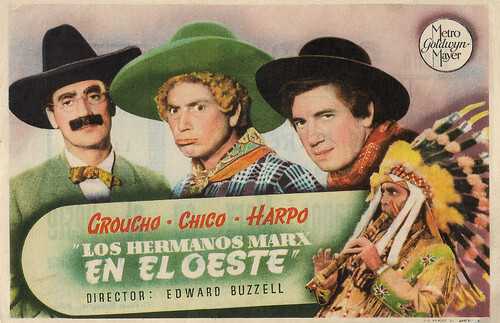
Spanish collectors card by J.G. Viladot, Barcelona. The Marx Brothers in Go West (Edward Buzzell, 1940). The Spanish title was Los Hermanos Marx en el oeste.
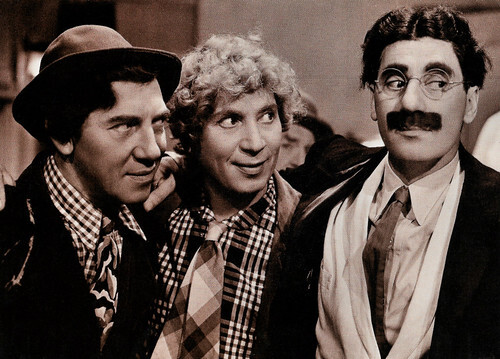
American postcard by Ludlow Sales, New York, N.Y, no. FC-105-50. Photo: MGM. The Marx Brothers in A Day at the Races (Sam Wood, 1935).
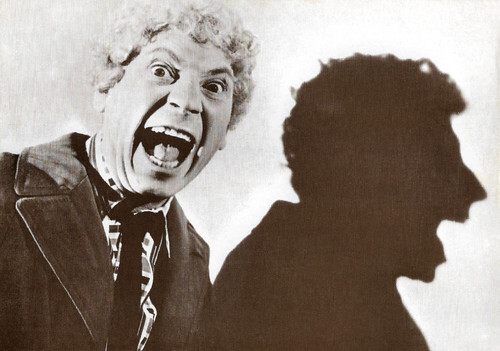
French postcard by Travelling Editions, Paris, no. CP 84. Harpo Marx.
Sources: Wikipedia (Dutch and German) and .

British postcard in the Picturegoer Series, London, no. 1219. Photo: Metro-Goldwyn-Mayer.

French postcard by Editions La Malibran, Paris / Saint-Dié, no. CA 4. Photo: The Marx Brothers in A Night at the Opera (Sam Wood, 1935). Caption: Harpo - Groucho - Chico Marx.

Belgian collectors card by Kwatta, Bois-d'Haine, no. C. 169 (in the series C. 99 - 196). Photo: M.G.M. The Marx Brothers in Go West (Edward Buzzell, 1940).
Chico, Harpo, Groucho, Gummo & Zeppo
The eldest Marx brother, Chico (1887-1961) was born Leonard Marx. Manfred was actually the eldest, but he died as a child. Chico was the one who decided to make musical comedies with his other brothers. At the time, he had learnt an Italian accent to convince any anti-Semites in the neighbourhood that he was Italian and not a Jew. This accent, along with his talent as a piano player, became one of his trademarks. In the films, he usually fulfilled the role of a sly and shady con man, the confidant of Harpo, a confident pianist and the sceptical assistant of Groucho.
Harpo (1888-1964) was born Adolph Marx and changed his name to Arthur in WWI because he found the name too German. As an actor, Harpo played the role of a mute, who never speaks but expresses himself through sign language, whistling and using his horn. Like a cross between a child and a wild beast, he sets everything in motion, harassing everyone, pulling the most peculiar things out of his coat (such as a candle burning on two sides, a coiled rope, a pin-up poster, etc.), and chasing women with his horn. His pseudonym "Harpo" was derived from the fact that he played the harp, for which there was a musical interlude in almost every film.
Groucho (1890-1977) was born Julius Henry Marx. His trademarks were his grin, thick cigar, waddling gait and sarcastic remarks, insults and puns. In the films, he was constantly trying to get money or women, talking everyone under the table with his witty and intelligent remarks. He was also a singer and some of his songs have become classics, such as 'Lydia the Tattooed Lady'.
Gummo (1892-1977) was born Milton Marx and was the least-known Marx brother. He was the one who first performed with Groucho, but before the big Broadway success came he had stopped acting. For years, he was his brother's manager.
Zeppo (1901-1979) was born Herbert Marx and was the youngest of the Marx Brothers. He took over the role of Gummo when the latter quit. Zeppo was the romantic declarer. Though he could take on more versatile roles, he was typecast as the most serious of the four.

Spanish collectors card by Graficas Valencia, Valencia. Photo: Filmofono. The Marx Brothers in Room Service (William A. Seiter, 1938). The Spanish title was El Hotel de los Lios.

Spanish collectors card by I.G. Viladot, Barcelona. Photo: Metro-Goldwyn-Mayer. The Marx Brothers in At the Circus (Edward Buzzell, 1939) with Kenny Baker and Florence Rice.

Spanish collectors card by Imp. Suso, Burgos. Photo: Filmofono. The Marx Brothers in A Night in Casablanca (Archie Mayo, 1946).
I'll say she is
The Marx Brothers were the five surviving sons of Sam and Minnie Marx. The family lived in Yorkville on New York's Upper East Side, a neighbourhood sandwiched between the Irish-German and Italian quarters.
Their career already began at the beginning of the century in vaudeville shows, with which their maternal uncle, Al Shean, had already been successful. Groucho Marx was the first to embark on a career on stage, but initially with very little success.
Their mother and sister also appeared on stage with their sons at times. However, the focus soon shifted from music and singing with humorous segues to comedy with musical interludes. The different roles of musicians and comedians crystallised relatively early.
While Chico developed the stereotype of the womaniser with an Italian accent who was always chasing the chicks, Groucho dropped his accent as a German during the First World War due to a lack of popularity. Harpo remained speechless on stage, as he had the greatest successes playing his jokes as a mime in a red or, in films, blond curly wig, or playing his grandmother's old harp.
A classroom sketch in which Groucho tried to teach his brothers evolved into the comedy show 'I'll Say She Is' which became their first success on Bradway and in England. This was followed by two more Broadway hits: 'The Cocoanuts' and 'Animal Crackers'. The Marx Brothers' shows became popular at a time when Hollywood was experiencing the transition from silent film to talkies. The brothers signed a contract with Paramount Pictures and thus launched their film career.

American postcard from the Marx Brothers Postcard Book by Green Wood, no. 1992. Caption: The Four Marx Brothers, Chico, Zeppo, Groucho and Harpo.

Canadian postcard by Canadian Postcard, no. A-57. Caption: Marx Brothers, Groucho, Harpo and Chico.

French postcard by Editions La Malibran, Paris / Saint-Dié, no. CA 5. Caption: Groucho - Harpo - Chico Marx.
Duck soup
The last two Broadway shows of The Marx Brothers became their first films, The Cocoanuts (Robert Florey, 1929) and Animal Crackers (Victor Heerman, 1930). Their next film was Monkey Business (Norman Z. McLeod, 1931). Between 1932 and 1933, a total of 26 episodes of the radio show 'Flywheel, Shyster & Flywheel' were made, with Groucho voicing the lawyer Waldorf T. Flywheel and Chico voicing his sidekick Emmanuel Ravelli. The first three episodes were broadcast under the title 'Beagle, Shyster & Beagle'. The title was then changed after a New York lawyer named "Beagle" threatened to sue. Some of the dialogue from the radio broadcasts was later used in the Marx Brothers films.
Their most successful film of the early period was Horse Feathers (Norman Z. McLeod, 1932), a satire on the American college system. But Duck Soup (Leo McCarey, 1933), generally considered their masterpiece, had much less success. It marked their break with Paramount. Zeppo, who always played serious roles, stopped making films after this. The Marx Brothers' first five films are generally considered their best, expressing their surrealist and anarchic humour in its purest form.
The three remaining brothers moved to Metro-Goldwyn-Mayer and changed the formula of their subsequent films. Their remaining films were given romantic plots and serious musical interludes, often intended as resting points between the often hilarious comic sketches. In A Night at the Opera (Sam Wood, 1935), a satire on the opera world, the brothers help two young singers in love. The film was very successful and was followed by the equally popular A Day at the Races (Sam Wood, 1937), where they kicked up a fuss at a race track. Several less memorable films followed until 1941. After the war, two more films A Night in Casablanca (Archie Mayo, 1946) and Love Happy (David Miller, 1949) followed to pay off Chico's gambling debts.
This was followed by the mediocre film The Story of Mankind (Irwin Allen, 1957), and a television special The Incredible Jewel Robbery (1959). These productions were already interludes, while each brother had already picked up a career of his own. Chico and Harpo continued on stage and Groucho had started a career as a radio and television entertainer. With his television and radio show 'You Bet Your Life', he became one of the most popular show hosts of the 1950s in the USA. The first episodes of the show were still broadcast live, as was customary at the time. But because Groucho's unbridled wordplay caused headaches for those in charge of the show, they deviated from this for later episodes and the programme was broadcast as a recording. He also wrote a number of books. Gummo and Zeppo ran a theatre agency together.
A final film project planned for 1960, starring the Marx Brothers once again and directed by Billy Wilder , did not materialise due to Chico's poor health. It was to be an anti-war satire in the style of Duck Soup. Even Groucho, who at the time was no longer very interested in further Marx Brothers films, is said to have been enthusiastic about the project because he considered Billy Wilder to be one of the best directors.

Spanish collectors card by J.G. Viladot, Barcelona. The Marx Brothers in Go West (Edward Buzzell, 1940). The Spanish title was Los Hermanos Marx en el oeste.

American postcard by Ludlow Sales, New York, N.Y, no. FC-105-50. Photo: MGM. The Marx Brothers in A Day at the Races (Sam Wood, 1935).

French postcard by Travelling Editions, Paris, no. CP 84. Harpo Marx.
Sources: Wikipedia (Dutch and German) and .
Published on July 27, 2023 22:00
July 26, 2023
Geraldine Brooks
American film, stage and television actress Geraldine Brooks (1925-1977) was a resolute, blue-eyed brunette with attractive, slightly pinched features. She played ingénue roles opposite Barbara Stanwyck and Joan Crawford. In Italy, she appeared in Vulcano/Volcano (1950) with Anna Magnani. Later she acted in a long string of television dramas, interrupted by summer stock and occasional films.
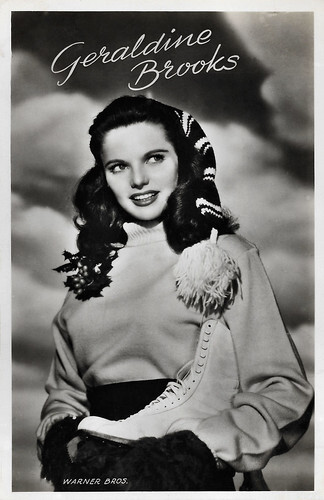
Dutch postcard by Fotoarchief Film en Toneel, no. 3441. Photo: Warner Bros.
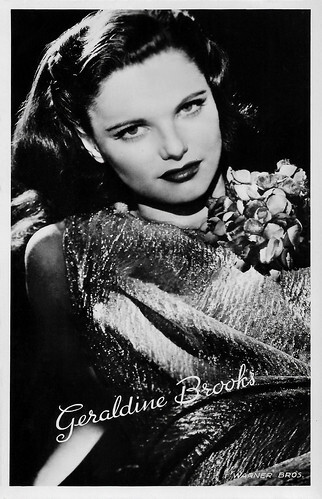
Dutch postcard, no. 3045. Photo: Warner Bros.
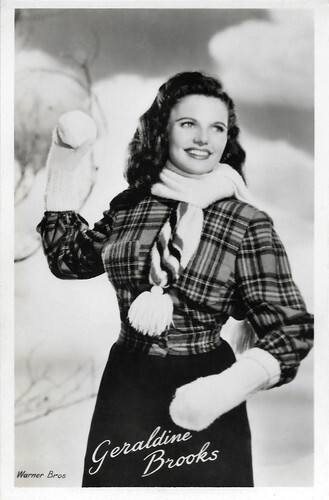
Dutch postcard, no. 3156. Photo: Warner Bros.
A promising debut
Geraldine Brooks was born Geraldine Stroock in 1925, in New York City. Her Dutch parents had a theatre-based background and her given name was in honour of opera star Geraldine Farrar. Her father, James Stroock, owned a top costume company and her mother, Bianca, was a costume designer and stylist. Little Geraldine was in dance shoes from age 2. Other relatives were also extensively involved in theatre - one aunt, Helen Stroock, was a former Ziegfeld Follies girl and another aunt, Rosa Olitza, was a contralto at the Metropolitan Opera until 1910. Her older sister, Gloria Stroock, also became an actress, primarily on TV.
Geraldine attended the Hunter Modeling School as a young teen and graduated from Julia Richman High School in 1942 as president of her drama club. In New York, Geraldine studied at the American Academy of Dramatic Art and the Neighborhood Playhouse. She debuted as an ingenue in summer stock productions at Bridgeport, Connecticut and at Montclair, New Jersey. In a pre-Broadway tryout of 'Follow the Girl' in 1944, Geraldine subsequently went with the show to Broadway in May of that same year and enjoyed a nine-month run.
Following her role as "Perdita" in 'A Winter's Tale' at the Theatre Guild, she was signed by Warner Bros. and made her film debut promisingly as a second femme lead in the mystery thriller Cry Wolf (Peter Godfrey, 1947) starring Barbara Stanwyck and Errol Flynn . At this time, she shunned her odd-sounding last name of "Stroock" in favour of the more euphonious marquee name of "Brooks", which was the name of her father's costume company. Playing Errol Flynn 's cool, conniving niece who gives trouble to Stanwyck, she gave added suspense to the film.
In her second film, the Film Noir Possessed (Curtis Bernhardt, 1947), she was again at odds with another powerhouse star, this time Joan Crawford , but showed more sensitivity against the manic Crawford character. Geraldine moved to dramatic lead status with Embraceable You (Felix Jacoves, 1948) opposite Dane Clark and played daughter to real wife-and-husband team Fredric March and Florence Eldridge in An Act of Murder (Michael Gordon, 1948), a drama that dealt with the topic of euthanasia.
Less impressive was the standard Warner Bros. "B" Western The Younger Brothers (Edwin L. Marin, 1949) and her MGM loan-out appearance in Challenge to Lassie (Richard Thorpe, 1949). Floundering a bit at this time and failing to strike a star-making chord with audiences, she attempted a few continental film assignments. In Italy, she acted opposite Vittorio Gassman in the melodrama Ho sognato il paradiso/Streets of Sorrow (Giorgio Pastina, 1950) and she played Anna Magnani's younger sister in Vulcano/Volcano (William Dieterle, 1950). She grew quickly disillusioned in Europe as well and returned to America.
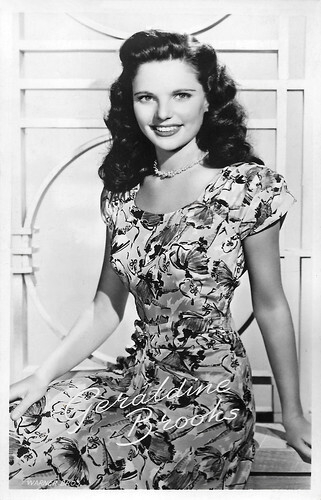
Dutch postcard by Fotoarchief Film en Toneel, no. AX 140 Photo: Warner Bros.
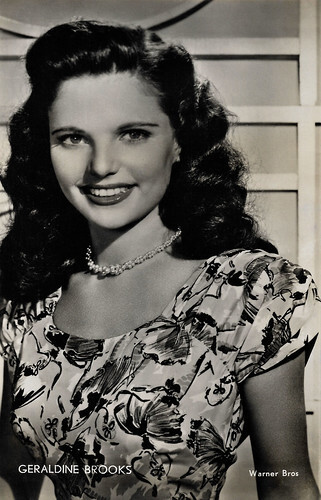
Vintage postcard, no. AX 140. Photo: Warner Bros.
A somewhat unsatisfying career
During the 1950s, Geraldine Brooks focused on stage and TV, including a Broadway stint in 'Time of the Cuckoo' starring Tony-winning Shirley Booth. Eventually, she went back to studying acting again. In 1956, she became a member of the Actor's Studio and a strong exponent of its method style. Despite this renewed, enlightening acting technique, her film career found no momentum at all.
In fact, she appeared in only two films in the oncoming years as brittle, harder-core ladies in Street of Sinners (William Berke, 1957) and Johnny Tiger (Paul Wendkos, 1966). Her greater notices were to be found guesting on various popular TV series. Particularly noteworthy were her roles on Perry Mason (1957), The Defenders (1961), Bus Stop (1961) - for which she earned an Emmy nomination, the pilot of Ironside (1967) and the last final climactic episode of The Fugitive (1963).
She was a regular as Dan Dailey's secretary on the mildly received Faraday and Company (1973). In the 1970s, Brooks also appeared in episodes of Kung Fu (1972), Cannon (1971), Barnaby Jones (1973) and McMillan & Wife (1971), in which her sister, Gloria Stroock, had a recurring role as Rock Hudson 's secretary.
Geraldine's later theatre included her Tony-nominated role in 'Brightower' (1970) despite it closing after only one performance on Broadway and as Tevye's wife, Golde, in the musical 'Fiddler on the Roof'. Gary Brumburgh at IMDb : "Her final movie part came in the rather ho-hum crime movie Mr. Ricco (Paul Bogart, 1975) alongside Dean Martin . A short-lived series regular as the matriarch of The Dumplings (1976), a rare comedic venture for her, and a stage production of Jules Feiffer's 'Hold Me!' in 1977 capped her capable but somewhat unsatisfying career. She deserved much better attention than she got, especially in films".
Divorced from TV writer Herbert Sargent after only three years (1958-1961), she married author Budd Schulberg, best known for his screenplay of On the Waterfront (Elia Kazan, 1954), in 1964. The couple moved to Los Angeles and for a time, set up a workshop for black writers in the Watts section of Los Angeles. In 1970, they returned to New York and, the following year bought a shore home at Quiogue in the Hamptons. Between television engagements, she gardened at Quiogue, tended her three cats and two adopted swans, and took up a new art, photography. She collaborated with Budd Schulberg on the book 'Swan Watch' (1975), a study on the elegant birds with her photographs and essays by Schulberg. In addition, she wrote poetry for children although she herself never had any. Sadly, Geraldine Brooks died in 1977 in Riverhead, New York, of a heart attack while battling cancer. She was only 51 and was survived by her husband, mother and sister.
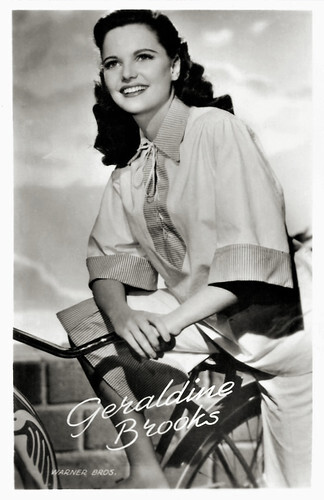
Dutch postcard. Photo: Warner Bros.
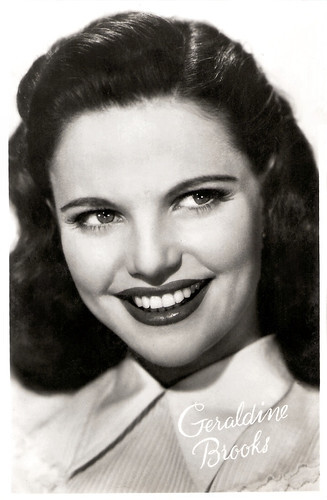
Dutch postcard. Photo: Warner Bros.
Sources: John L. Hess (The New York Times), (IMDb), Wikipedia and .

Dutch postcard by Fotoarchief Film en Toneel, no. 3441. Photo: Warner Bros.

Dutch postcard, no. 3045. Photo: Warner Bros.

Dutch postcard, no. 3156. Photo: Warner Bros.
A promising debut
Geraldine Brooks was born Geraldine Stroock in 1925, in New York City. Her Dutch parents had a theatre-based background and her given name was in honour of opera star Geraldine Farrar. Her father, James Stroock, owned a top costume company and her mother, Bianca, was a costume designer and stylist. Little Geraldine was in dance shoes from age 2. Other relatives were also extensively involved in theatre - one aunt, Helen Stroock, was a former Ziegfeld Follies girl and another aunt, Rosa Olitza, was a contralto at the Metropolitan Opera until 1910. Her older sister, Gloria Stroock, also became an actress, primarily on TV.
Geraldine attended the Hunter Modeling School as a young teen and graduated from Julia Richman High School in 1942 as president of her drama club. In New York, Geraldine studied at the American Academy of Dramatic Art and the Neighborhood Playhouse. She debuted as an ingenue in summer stock productions at Bridgeport, Connecticut and at Montclair, New Jersey. In a pre-Broadway tryout of 'Follow the Girl' in 1944, Geraldine subsequently went with the show to Broadway in May of that same year and enjoyed a nine-month run.
Following her role as "Perdita" in 'A Winter's Tale' at the Theatre Guild, she was signed by Warner Bros. and made her film debut promisingly as a second femme lead in the mystery thriller Cry Wolf (Peter Godfrey, 1947) starring Barbara Stanwyck and Errol Flynn . At this time, she shunned her odd-sounding last name of "Stroock" in favour of the more euphonious marquee name of "Brooks", which was the name of her father's costume company. Playing Errol Flynn 's cool, conniving niece who gives trouble to Stanwyck, she gave added suspense to the film.
In her second film, the Film Noir Possessed (Curtis Bernhardt, 1947), she was again at odds with another powerhouse star, this time Joan Crawford , but showed more sensitivity against the manic Crawford character. Geraldine moved to dramatic lead status with Embraceable You (Felix Jacoves, 1948) opposite Dane Clark and played daughter to real wife-and-husband team Fredric March and Florence Eldridge in An Act of Murder (Michael Gordon, 1948), a drama that dealt with the topic of euthanasia.
Less impressive was the standard Warner Bros. "B" Western The Younger Brothers (Edwin L. Marin, 1949) and her MGM loan-out appearance in Challenge to Lassie (Richard Thorpe, 1949). Floundering a bit at this time and failing to strike a star-making chord with audiences, she attempted a few continental film assignments. In Italy, she acted opposite Vittorio Gassman in the melodrama Ho sognato il paradiso/Streets of Sorrow (Giorgio Pastina, 1950) and she played Anna Magnani's younger sister in Vulcano/Volcano (William Dieterle, 1950). She grew quickly disillusioned in Europe as well and returned to America.

Dutch postcard by Fotoarchief Film en Toneel, no. AX 140 Photo: Warner Bros.

Vintage postcard, no. AX 140. Photo: Warner Bros.
A somewhat unsatisfying career
During the 1950s, Geraldine Brooks focused on stage and TV, including a Broadway stint in 'Time of the Cuckoo' starring Tony-winning Shirley Booth. Eventually, she went back to studying acting again. In 1956, she became a member of the Actor's Studio and a strong exponent of its method style. Despite this renewed, enlightening acting technique, her film career found no momentum at all.
In fact, she appeared in only two films in the oncoming years as brittle, harder-core ladies in Street of Sinners (William Berke, 1957) and Johnny Tiger (Paul Wendkos, 1966). Her greater notices were to be found guesting on various popular TV series. Particularly noteworthy were her roles on Perry Mason (1957), The Defenders (1961), Bus Stop (1961) - for which she earned an Emmy nomination, the pilot of Ironside (1967) and the last final climactic episode of The Fugitive (1963).
She was a regular as Dan Dailey's secretary on the mildly received Faraday and Company (1973). In the 1970s, Brooks also appeared in episodes of Kung Fu (1972), Cannon (1971), Barnaby Jones (1973) and McMillan & Wife (1971), in which her sister, Gloria Stroock, had a recurring role as Rock Hudson 's secretary.
Geraldine's later theatre included her Tony-nominated role in 'Brightower' (1970) despite it closing after only one performance on Broadway and as Tevye's wife, Golde, in the musical 'Fiddler on the Roof'. Gary Brumburgh at IMDb : "Her final movie part came in the rather ho-hum crime movie Mr. Ricco (Paul Bogart, 1975) alongside Dean Martin . A short-lived series regular as the matriarch of The Dumplings (1976), a rare comedic venture for her, and a stage production of Jules Feiffer's 'Hold Me!' in 1977 capped her capable but somewhat unsatisfying career. She deserved much better attention than she got, especially in films".
Divorced from TV writer Herbert Sargent after only three years (1958-1961), she married author Budd Schulberg, best known for his screenplay of On the Waterfront (Elia Kazan, 1954), in 1964. The couple moved to Los Angeles and for a time, set up a workshop for black writers in the Watts section of Los Angeles. In 1970, they returned to New York and, the following year bought a shore home at Quiogue in the Hamptons. Between television engagements, she gardened at Quiogue, tended her three cats and two adopted swans, and took up a new art, photography. She collaborated with Budd Schulberg on the book 'Swan Watch' (1975), a study on the elegant birds with her photographs and essays by Schulberg. In addition, she wrote poetry for children although she herself never had any. Sadly, Geraldine Brooks died in 1977 in Riverhead, New York, of a heart attack while battling cancer. She was only 51 and was survived by her husband, mother and sister.

Dutch postcard. Photo: Warner Bros.

Dutch postcard. Photo: Warner Bros.
Sources: John L. Hess (The New York Times), (IMDb), Wikipedia and .
Published on July 26, 2023 22:00
July 25, 2023
Das verwunschene Schloß (1918)
During the First World War and the following years, Hella Moja was one of the most popular stars of German silent cinema. There was even a Hella Moja serial and in 1918 she founded her own film company. One of her films for the Decla that year was Das verwunschene Schloß/The haunted castle (Otto Rippert, 1918). Her co-star was Carl Auen, who often appeared in silent films as the handsome gentleman, officer or nobleman.
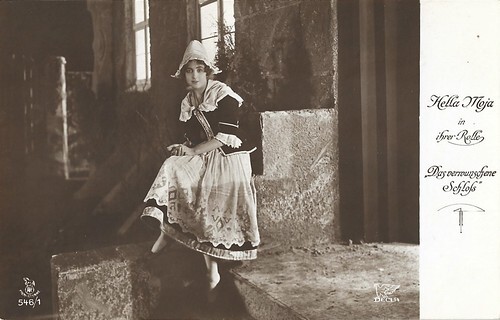
German postcard by Rotophot in the Film-Sterne series, no. 546/1. Photo: Decla. Hella Moja as Veronika in Das verwunschene Schloß/The Haunted Castle (Otto Rippert, 1918).
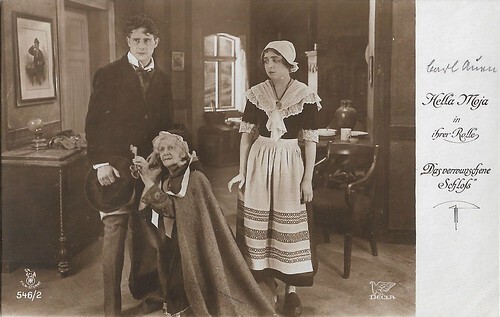
German postcard by Rotophot in the Film-Sterne series, no. 546/2. Photo: Decla. On the right, Hella Moja as Veronika, Carl Auen as Gontard, and Lina Paulsen as Ursula in Das verwunschene Schloß (Otto Rippert, 1918).
Changing his own child in the cradle with the count's daughter
Das verwunschene Schloß/The haunted castle (Otto Rippert, 1918) was produced by Erich Pommer for Decla-Film-Ges. Holz & Co. in Berlin, and was written by Julius Sternheim. Count von Groningen (Max Ruhbeck) left his castle twenty years ago. Since then, the castle is considered haunted.
Shortly before his flight, the count has given his newborn child in custody to the administrator and farmer Grödner ( Werner Krauss ). Perfid Grödner exchanges his own child Gisela with the count's daughter Veronika in the cradle, hoping to get possession of the castle in this way.
Gisela, now called Veronika ( Hella Moja ), and Veronika, now called Gisela (Erra Bognar), grow up like sisters in the manor. One day the two girls meet a travelling singer named Gontard ( Carl Auen ) during a walk. He quickly takes a liking to Veronika. At the same time as Gontard's appearance, a new bailiff (Magnus Stifter) appears in town. He is sent to find out what the story of the haunted stories at Groningen Castle is about.
The following evening there is a village ball, where Veronika, Gisela, and Gontard are present too. While the villager Franz (Joseph Coenen) hits on Gisela, Gontard and Veronika notice a cone of light emerging from the supposedly uninhabited castle.
The village community is alerted and people go to Grödner to ask for the key to the castle gate, but he cannot be tracked. The bailiff rightly assumes that Grödner has selfishly organised this haunt to keep strangers away from the castle, but the official lacks the evidence to pin him down and imprison him for gross mischief.
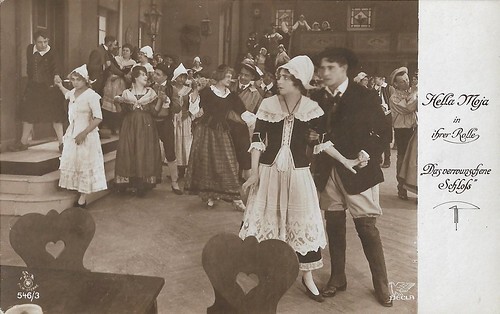
German postcard by Rotophot in the Film-Sterne series, no. 546/3. Photo: Decla. On the right, Hella Moja as Veronika and Carl Auen as Gontard in Das verwunschene Schloß (Otto Rippert, 1918). The couple on the left are Erra Bognar (Gisela) and Joseph Coenen (Franz).
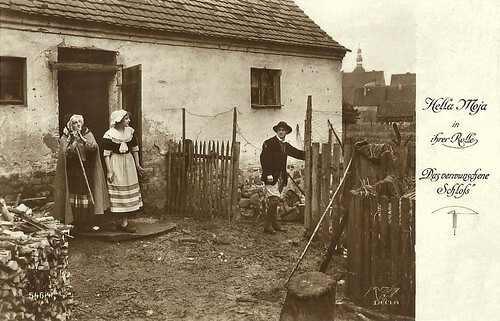
German postcard in the Film Sterne series by Rotophot, no. 546/4. Photoc: Decla. Hella Moja as Veronika, Lina Paulsen as Ursula, and Carl Auen as Gontard in Das verwunschene Schloß (Otto Rippert, 1918).
A cypher, hidden in a medallion to open an iron door
Veronika and Gontard are getting closer. The young man discovers a medallion on her neck, which he once gave to a girl whom he had fished out of a lake shortly before. Now old Ursula (Lina Paulsen), once the nurse of the count's daughter, recognises the nephew of the old count in Gontard.
Ursula asks him to get the castle key from Grödner and take possession of the castle. The latter not only sees his plot fail to grab the castle but also realises that his baby swap from twenty years ago threatens to be exposed. He has a fit of rage.
Gontard becomes suspicious and rummages through documents that eventually substantiate his suspicion that the manager had once replaced the babies. This is a blessing for Franz, he thought that his "Gisela" was the count's daughter, whom he could impossibly marry because of the class difference.
Gontard and Franz decide to put a stop to the villainous Gördner. Both sneak into the castle and wait for the culprit's return to organise his nightly light games. In fact, the steward appears and a fight follows. Dying, the villain admits the former baby exchange. Using a cypher hidden in Veronika's medallion, the two men manage to open a locked iron door, behind which Gördner has locked Veronika and the wet nurse. Now Gontard can finally marry the wrong Veronika, who is actually Countess Gisela.
Neue Kino-Rundschau reviewed the film on 27 July 1918: "This romantic film takes us to the land of fairy tales. Hella Moja once again conquers us with her acting. In the scene in which the poor peasant girl transforms into the rich countess, she plays so naturally that she must necessarily appear pleasant and convincing to the viewer. The other actors also fulfil their roles to the full. The extremely exciting plot, in which especially the splendidly executed crowd scenes reveal the work of the expert director, keeps our interest up to the last minute. The charming rural milieu and the good photography are further assets of the picture."
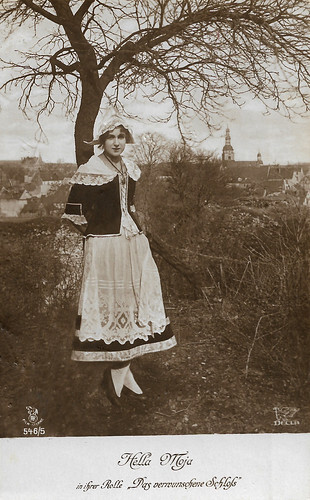
German postcard by Rotophot in the Film-Sterne series, no. 546/5. Photo: Decla. Hella Moja as Veronika in Das verwunschene Schloß (Otto Rippert, 1918).
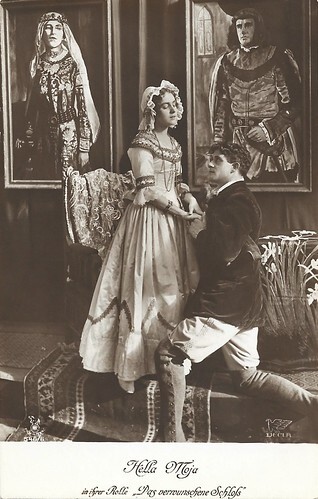
German postcard by Rotophot in the Film-Sterne series, no. 546/6. Photo: Decla. Hella Moja as Veronika and Carl Auen as Gontard in Das verwunschene Schloß/The haunted castle (Otto Rippert, 1918).
Sources: Filmportal.de, Wikipedia (German) and IMDb.

German postcard by Rotophot in the Film-Sterne series, no. 546/1. Photo: Decla. Hella Moja as Veronika in Das verwunschene Schloß/The Haunted Castle (Otto Rippert, 1918).

German postcard by Rotophot in the Film-Sterne series, no. 546/2. Photo: Decla. On the right, Hella Moja as Veronika, Carl Auen as Gontard, and Lina Paulsen as Ursula in Das verwunschene Schloß (Otto Rippert, 1918).
Changing his own child in the cradle with the count's daughter
Das verwunschene Schloß/The haunted castle (Otto Rippert, 1918) was produced by Erich Pommer for Decla-Film-Ges. Holz & Co. in Berlin, and was written by Julius Sternheim. Count von Groningen (Max Ruhbeck) left his castle twenty years ago. Since then, the castle is considered haunted.
Shortly before his flight, the count has given his newborn child in custody to the administrator and farmer Grödner ( Werner Krauss ). Perfid Grödner exchanges his own child Gisela with the count's daughter Veronika in the cradle, hoping to get possession of the castle in this way.
Gisela, now called Veronika ( Hella Moja ), and Veronika, now called Gisela (Erra Bognar), grow up like sisters in the manor. One day the two girls meet a travelling singer named Gontard ( Carl Auen ) during a walk. He quickly takes a liking to Veronika. At the same time as Gontard's appearance, a new bailiff (Magnus Stifter) appears in town. He is sent to find out what the story of the haunted stories at Groningen Castle is about.
The following evening there is a village ball, where Veronika, Gisela, and Gontard are present too. While the villager Franz (Joseph Coenen) hits on Gisela, Gontard and Veronika notice a cone of light emerging from the supposedly uninhabited castle.
The village community is alerted and people go to Grödner to ask for the key to the castle gate, but he cannot be tracked. The bailiff rightly assumes that Grödner has selfishly organised this haunt to keep strangers away from the castle, but the official lacks the evidence to pin him down and imprison him for gross mischief.

German postcard by Rotophot in the Film-Sterne series, no. 546/3. Photo: Decla. On the right, Hella Moja as Veronika and Carl Auen as Gontard in Das verwunschene Schloß (Otto Rippert, 1918). The couple on the left are Erra Bognar (Gisela) and Joseph Coenen (Franz).

German postcard in the Film Sterne series by Rotophot, no. 546/4. Photoc: Decla. Hella Moja as Veronika, Lina Paulsen as Ursula, and Carl Auen as Gontard in Das verwunschene Schloß (Otto Rippert, 1918).
A cypher, hidden in a medallion to open an iron door
Veronika and Gontard are getting closer. The young man discovers a medallion on her neck, which he once gave to a girl whom he had fished out of a lake shortly before. Now old Ursula (Lina Paulsen), once the nurse of the count's daughter, recognises the nephew of the old count in Gontard.
Ursula asks him to get the castle key from Grödner and take possession of the castle. The latter not only sees his plot fail to grab the castle but also realises that his baby swap from twenty years ago threatens to be exposed. He has a fit of rage.
Gontard becomes suspicious and rummages through documents that eventually substantiate his suspicion that the manager had once replaced the babies. This is a blessing for Franz, he thought that his "Gisela" was the count's daughter, whom he could impossibly marry because of the class difference.
Gontard and Franz decide to put a stop to the villainous Gördner. Both sneak into the castle and wait for the culprit's return to organise his nightly light games. In fact, the steward appears and a fight follows. Dying, the villain admits the former baby exchange. Using a cypher hidden in Veronika's medallion, the two men manage to open a locked iron door, behind which Gördner has locked Veronika and the wet nurse. Now Gontard can finally marry the wrong Veronika, who is actually Countess Gisela.
Neue Kino-Rundschau reviewed the film on 27 July 1918: "This romantic film takes us to the land of fairy tales. Hella Moja once again conquers us with her acting. In the scene in which the poor peasant girl transforms into the rich countess, she plays so naturally that she must necessarily appear pleasant and convincing to the viewer. The other actors also fulfil their roles to the full. The extremely exciting plot, in which especially the splendidly executed crowd scenes reveal the work of the expert director, keeps our interest up to the last minute. The charming rural milieu and the good photography are further assets of the picture."

German postcard by Rotophot in the Film-Sterne series, no. 546/5. Photo: Decla. Hella Moja as Veronika in Das verwunschene Schloß (Otto Rippert, 1918).

German postcard by Rotophot in the Film-Sterne series, no. 546/6. Photo: Decla. Hella Moja as Veronika and Carl Auen as Gontard in Das verwunschene Schloß/The haunted castle (Otto Rippert, 1918).
Sources: Filmportal.de, Wikipedia (German) and IMDb.
Published on July 25, 2023 22:00
July 24, 2023
The Moon Riders (1920)
The Moonriders (B. Reeves Eason, Theodore Wharton, 1920) is a lost American Western serial, distributed by Universal. The stars were Art Acord and Mildred Moore. The serial counted 18 episodes. Chocolate Pi in Barcelona published a series of 54 cromo cards of the serial which was distributed in Spain by Cinematografica Verdaguer under the title Los Jinetes de la Luna.

Spanish collectors card by Chocolate Pi, Barcelona, no. 5 of 54 cromo cards. Photo: Cinematografica Verdaguer, Barcelona. Art Acord in The Moonriders (B. Reeves Eason, Theodore Wharton, 1920).

Spanish collectors card by Chocolate Pi, Barcelona, no. 7 of 54 cromo cards. Photo: Cinematografica Verdaguer, Barcelona. Art Acord, right, in The Moonriders (B. Reeves Eason, Theodore Wharton, 1920).

Spanish collectors card by Chocolate Pi, Barcelona, no. 11 of 54 cromo cards. Photo: Cinematografica Verdaguer, Barcelona. Beatrice Dominguez, Art Acord, George Field, Charles Newton and Mildred Moore in The Moonriders (B. Reeves Eason, Theodore Wharton, 1920).

Spanish collectors card by Chocolate Pi, Barcelona, no. 24 of 54 cromo cards. Photo: Cinematografica Verdaguer, Barcelona. Mildred Moore, Charles Newton and Art Acord in The Moonriders (B. Reeves Eason, Theodore Wharton, 1920).
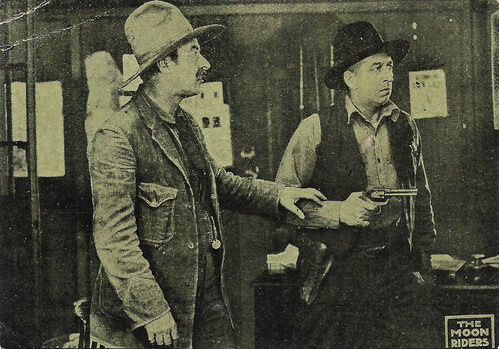
Spanish collectors card by Chocolate Pi, Barcelona, no. 28 of 54 cromo cards. Photo: Cinematografica Verdaguer, Barcelona. Charles Newton, left, in The Moonriders (B. Reeves Eason, Theodore Wharton, 1920).
Outlaws, skull-mased Indians and a fantastic treasure
"The Moon Riders is considered to be one of the more successful serials of the silent film era and it established Art Acord as a western star", according to Wikipedia . IMDb tells about the plot: "The struggle of a group of homesteaders against an unscrupulous band that desires to profit through obsolete Spanish land grants." Serial Squadron adds: "Cowboy Buck Ravelle has to contend with a band of outlaws and a lost, skull-masked Indian tribe to recover a fantastic treasure."
Acord played the lead as the ranger Buck Ravelle, Mildred Moore played Anna Baldwin, Charles Newton played her father, Arizona Baldwin, George Field was Egbert, the leader of the gang, Beatrice Dominguez was the housekeeper's daughter Rosa, and the Native American actor Tote Du Crow was Warpee, the Indian Chief.
Gary Eugene Brown writes on High Noon , "Universal signed Art to make cowboy pictures (1919). The first production was an eighteen-chapter serial The Moon Riders. While filming an episode, Art's horse slipped, reared up and was going to fall into a ravine. Art could have bailed off; however, his costar Mildred Moore was mounted with him. Art jerked on the reins to balance the horse momentarily, in order to lower Mildred to the ground and then his horse fell taking Art with him.
The production was halted for two months while Art recuperated from severe injuries. After the serial, which was well received: "unusually good....... the best western serial we have ever seen", Universal didn't renew his contract. Art eventually signed with a Poverty Row studio to make inferior westerns." Yet, Universal realized its mistake and he was rehired in 1921, doing successful films for them like Winners of the West (1921).
The chapter titles of The Moon Riders are 1. Over the Precipice. 2. The Masked Marauders. 3. The Red Rage of Jealousy. 4. Vultures of the Hills. 5. The Death Trap. 6. Caves of Mystery. 7. The Menacing Monster. 8. At the Rope's End. 9. The Triple Menace. 10. The Moon Rider's Bride. 11. Death's Door. 12. The Pit of Fire. 13. The House of Doom. 14. Unmasked. 15. His Hour of Torture. 16. The Flaming Peril. 17. Rushing Waters. 18. Clearing Skies.
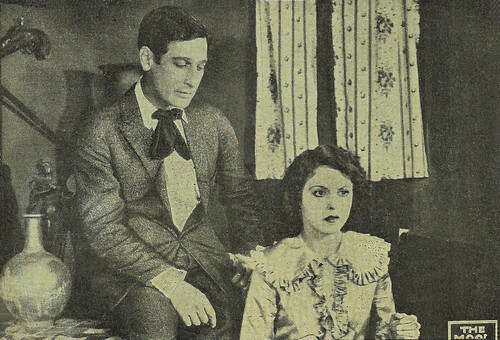
Spanish collectors card by Chocolate Pi, Barcelona, no. 29 of 54 cromo cards. Photo: Cinematografica Verdaguer, Barcelona. George Field, and Mildred Moore in The Moonriders (B. Reeves Eason, Theodore Wharton, 1920).
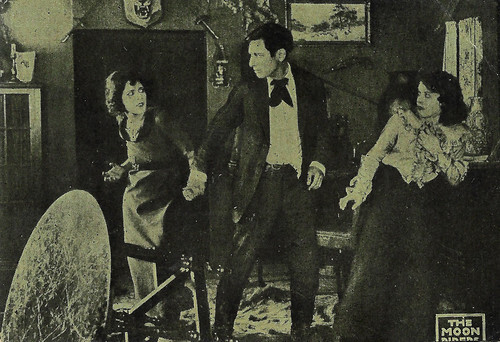
Spanish collectors card by Chocolate Pi, Barcelona, no. 33 of 54 cromo cards. Photo: Cinematografica Verdaguer, Barcelona. Mildred Moore, George Field and Beatrice Dominguez in The Moonriders (B. Reeves Eason, Theodore Wharton, 1920).
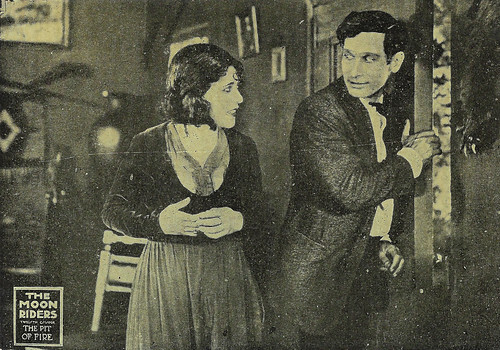
Spanish collectors card by Chocolate Pi, Barcelona, no. 35 of 54 cromo cards. Photo: Cinematografica Verdaguer, Barcelona. Beatrice Dominguez and George Field in The Moonriders (B. Reeves Eason, Theodore Wharton, 1920).
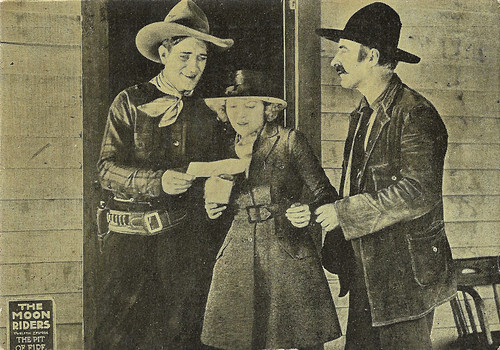
Spanish collectors card by Chocolate Pi, Barcelona, no. 37 of 54 cromo cards. Photo: Cinematografica Verdaguer, Barcelona. Art Acord, Mildred Moore and Charles Newton in The Moonriders (B. Reeves Eason, Theodore Wharton, 1920).
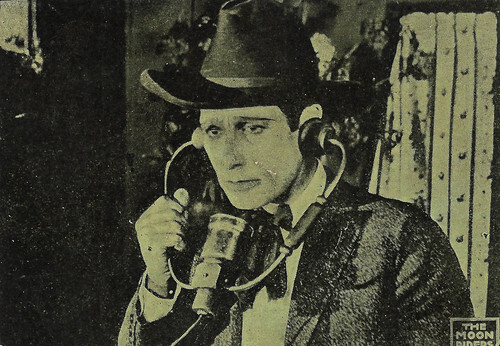
Spanish collectors card by Chocolate Pi, Barcelona, no. 43 of 54 cromo cards. Photo: Cinematografica Verdaguer, Barcelona. George Field in The Moonriders (B. Reeves Eason, Theodore Wharton, 1920).
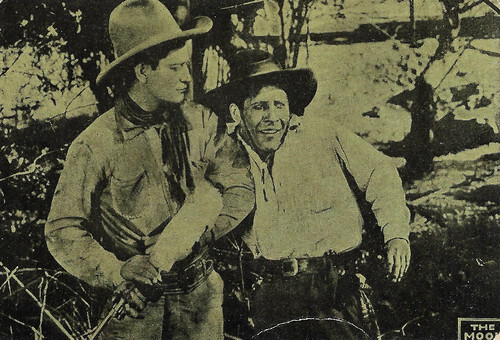
Spanish collectors card by Chocolate Pi, Barcelona, no. 44 of 54 cromo cards. Photo: Cinematografica Verdaguer, Barcelona. Art Acord, left, in The Moonriders (B. Reeves Eason, Theodore Wharton, 1920).
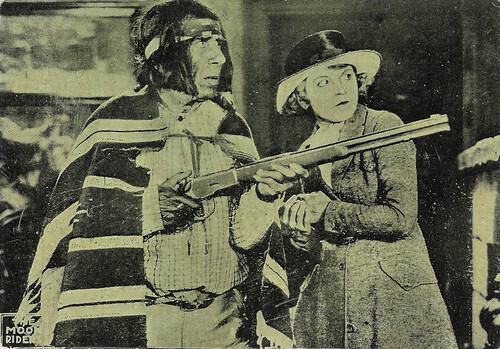
Spanish collectors card by Chocolate Pi, Barcelona, no. 45 of 54 cromo cards. Photo: Cinematografica Verdaguer, Barcelona. Mildred Moore and Tote du Crow in The Moonriders (B. Reeves Eason, Theodore Wharton, 1920).
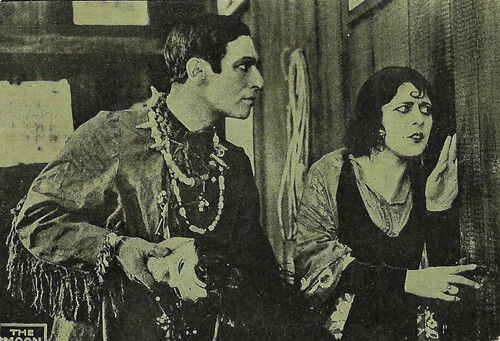
Spanish collectors card by Chocolate Pi, Barcelona, no. 52 of 54 cromo cards. Photo: Cinematografica Verdaguer, Barcelona. George Field and probably Beatrice Dominguez in The Moonriders (B. Reeves Eason, Theodore Wharton, 1920).
Sources: Gary Eugene Brown (Hign Noon), Serial Squadron, Wikipedia and IMDb.

Spanish collectors card by Chocolate Pi, Barcelona, no. 5 of 54 cromo cards. Photo: Cinematografica Verdaguer, Barcelona. Art Acord in The Moonriders (B. Reeves Eason, Theodore Wharton, 1920).

Spanish collectors card by Chocolate Pi, Barcelona, no. 7 of 54 cromo cards. Photo: Cinematografica Verdaguer, Barcelona. Art Acord, right, in The Moonriders (B. Reeves Eason, Theodore Wharton, 1920).

Spanish collectors card by Chocolate Pi, Barcelona, no. 11 of 54 cromo cards. Photo: Cinematografica Verdaguer, Barcelona. Beatrice Dominguez, Art Acord, George Field, Charles Newton and Mildred Moore in The Moonriders (B. Reeves Eason, Theodore Wharton, 1920).

Spanish collectors card by Chocolate Pi, Barcelona, no. 24 of 54 cromo cards. Photo: Cinematografica Verdaguer, Barcelona. Mildred Moore, Charles Newton and Art Acord in The Moonriders (B. Reeves Eason, Theodore Wharton, 1920).

Spanish collectors card by Chocolate Pi, Barcelona, no. 28 of 54 cromo cards. Photo: Cinematografica Verdaguer, Barcelona. Charles Newton, left, in The Moonriders (B. Reeves Eason, Theodore Wharton, 1920).
Outlaws, skull-mased Indians and a fantastic treasure
"The Moon Riders is considered to be one of the more successful serials of the silent film era and it established Art Acord as a western star", according to Wikipedia . IMDb tells about the plot: "The struggle of a group of homesteaders against an unscrupulous band that desires to profit through obsolete Spanish land grants." Serial Squadron adds: "Cowboy Buck Ravelle has to contend with a band of outlaws and a lost, skull-masked Indian tribe to recover a fantastic treasure."
Acord played the lead as the ranger Buck Ravelle, Mildred Moore played Anna Baldwin, Charles Newton played her father, Arizona Baldwin, George Field was Egbert, the leader of the gang, Beatrice Dominguez was the housekeeper's daughter Rosa, and the Native American actor Tote Du Crow was Warpee, the Indian Chief.
Gary Eugene Brown writes on High Noon , "Universal signed Art to make cowboy pictures (1919). The first production was an eighteen-chapter serial The Moon Riders. While filming an episode, Art's horse slipped, reared up and was going to fall into a ravine. Art could have bailed off; however, his costar Mildred Moore was mounted with him. Art jerked on the reins to balance the horse momentarily, in order to lower Mildred to the ground and then his horse fell taking Art with him.
The production was halted for two months while Art recuperated from severe injuries. After the serial, which was well received: "unusually good....... the best western serial we have ever seen", Universal didn't renew his contract. Art eventually signed with a Poverty Row studio to make inferior westerns." Yet, Universal realized its mistake and he was rehired in 1921, doing successful films for them like Winners of the West (1921).
The chapter titles of The Moon Riders are 1. Over the Precipice. 2. The Masked Marauders. 3. The Red Rage of Jealousy. 4. Vultures of the Hills. 5. The Death Trap. 6. Caves of Mystery. 7. The Menacing Monster. 8. At the Rope's End. 9. The Triple Menace. 10. The Moon Rider's Bride. 11. Death's Door. 12. The Pit of Fire. 13. The House of Doom. 14. Unmasked. 15. His Hour of Torture. 16. The Flaming Peril. 17. Rushing Waters. 18. Clearing Skies.

Spanish collectors card by Chocolate Pi, Barcelona, no. 29 of 54 cromo cards. Photo: Cinematografica Verdaguer, Barcelona. George Field, and Mildred Moore in The Moonriders (B. Reeves Eason, Theodore Wharton, 1920).

Spanish collectors card by Chocolate Pi, Barcelona, no. 33 of 54 cromo cards. Photo: Cinematografica Verdaguer, Barcelona. Mildred Moore, George Field and Beatrice Dominguez in The Moonriders (B. Reeves Eason, Theodore Wharton, 1920).

Spanish collectors card by Chocolate Pi, Barcelona, no. 35 of 54 cromo cards. Photo: Cinematografica Verdaguer, Barcelona. Beatrice Dominguez and George Field in The Moonriders (B. Reeves Eason, Theodore Wharton, 1920).

Spanish collectors card by Chocolate Pi, Barcelona, no. 37 of 54 cromo cards. Photo: Cinematografica Verdaguer, Barcelona. Art Acord, Mildred Moore and Charles Newton in The Moonriders (B. Reeves Eason, Theodore Wharton, 1920).

Spanish collectors card by Chocolate Pi, Barcelona, no. 43 of 54 cromo cards. Photo: Cinematografica Verdaguer, Barcelona. George Field in The Moonriders (B. Reeves Eason, Theodore Wharton, 1920).

Spanish collectors card by Chocolate Pi, Barcelona, no. 44 of 54 cromo cards. Photo: Cinematografica Verdaguer, Barcelona. Art Acord, left, in The Moonriders (B. Reeves Eason, Theodore Wharton, 1920).

Spanish collectors card by Chocolate Pi, Barcelona, no. 45 of 54 cromo cards. Photo: Cinematografica Verdaguer, Barcelona. Mildred Moore and Tote du Crow in The Moonriders (B. Reeves Eason, Theodore Wharton, 1920).

Spanish collectors card by Chocolate Pi, Barcelona, no. 52 of 54 cromo cards. Photo: Cinematografica Verdaguer, Barcelona. George Field and probably Beatrice Dominguez in The Moonriders (B. Reeves Eason, Theodore Wharton, 1920).
Sources: Gary Eugene Brown (Hign Noon), Serial Squadron, Wikipedia and IMDb.
Published on July 24, 2023 22:00
July 23, 2023
Peter O'Toole
Golden-haired, blue-eyed Peter O'Toole (1932-2013) became an international superstar with his unforgettable turn as the British expatriate T.E. Lawrence in David Lean's epic masterpiece Lawrence of Arabia (1962). After surviving cancer and alcoholism, the British actor made a triumphant come-back with Oscar-nominated appearances in The Stunt Man (1980) and My Favorite Year (1982).
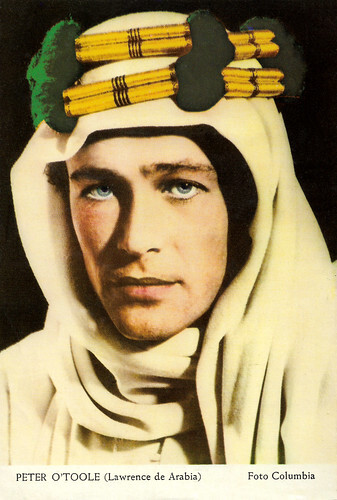
Dutch card. Photo: Columbia. Peter O'Toole in Lawrence of Arabia (David Lean, 1962).
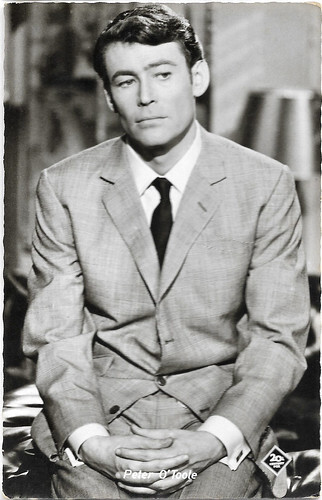
West German postcard by Kolibri, Minden/Westf, no. 2630. Photo: 20th Century Fox. Peter O'Toole in How to Steal a Million (William Wyler, 1966).
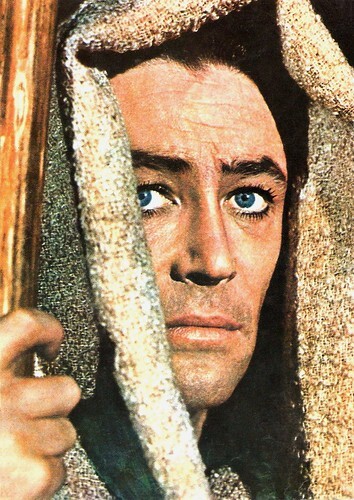
Romanian postcard by Casa Filmului Acin. Peter O'Toole in The Bible: In The Beginning... (John Huston, 1966).
Intensity and zeal
Peter Seamus Lorcan O'Toole was born in 1932. According to IMDb , he was born in Connemara, Ireland. Other sources indicate Leeds, England, where he also grew up, as his birthplace. In his autobiography 'Loitering with Intent: the Child' (1992), O’Toole wrote that he was not certain of his birthplace, while he had birth certificates from two countries.
However, he was the son of Constance Jane (née Ferguson), a Scottish nurse, and Patrick Joseph O'Toole, an Irish metal platter, football player and racecourse bookmaker. As a boy, Peter decided to become a journalist, beginning as a newspaper copyboy. Although he succeeded in becoming a reporter, he discovered the theatre and made his stage debut at 17. He served as a radioman in the Royal Navy for two years.
From 1952 to 1954 he attended the Royal Academy of Dramatic Art as a scholarship student. His classmates included Albert Finney , Alan Bates and Richard Harris. While at RADA he was active in protesting the British involvement in the Korean War. Later in the 1960s, he would be an active opponent of the Vietnam War. O'Toole began working in the theatre, gaining recognition as a Shakespearean actor at the Bristol Old Vic and with the English Stage Company, before making an inconspicuous film debut in the Walt Disney production Kidnapped (Robert Stevenson, 1960), a faithful adaptation of the Robert Louis Stevenson classic.
Two years later, O'Toole was chosen by director David Lean to play Thomas E. Lawrence in Lawrence of Arabia (David Lean, 1962). The part of the conflicted British liaison officer caught at the centre of an Arab revolt made O'Toole an international superstar. Brian McFarlane observes in the Encyclopaedia of British Film : “It was a remarkable study in obsession, catching the right balance between mystic and man of action, bringing to the role kinds of intensity and zeal that few other British actors could have done”.
Peter O'Toole continued successfully in artistically rich films as well as less artistic but commercially rewarding projects. He was nominated as Best Actor for King Henry II in Becket (Peter Glenville, 1964) starring Richard Burton . Two years later he was nominated again for portraying Henry II, this time in The Lion in Winter (Anthony Harvey, 1968) alongside Katharine Hepburn .
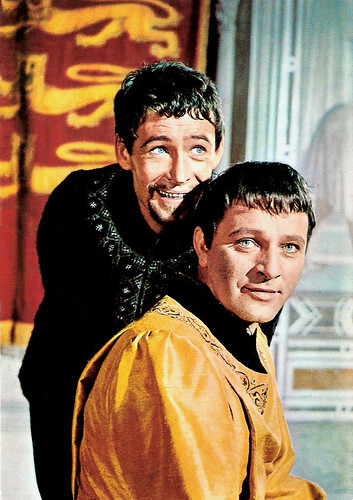
Spanish postcard by Postal Oscarcolor, no. 279. Photo: Publicity shot for Becket (Peter Glenville, 1964) with Richard Burton .
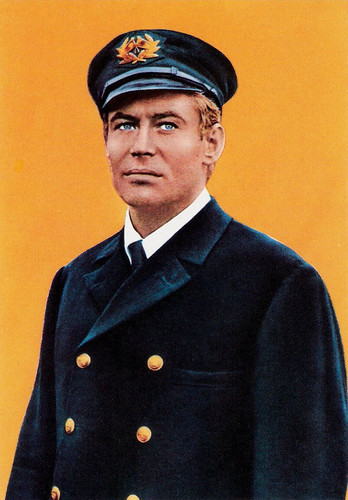
Italian postcard by Rotalfoto, Milano (Milan), no. 278. Peter O'Toole in Lord Jim (Richard Brooks, 1965).
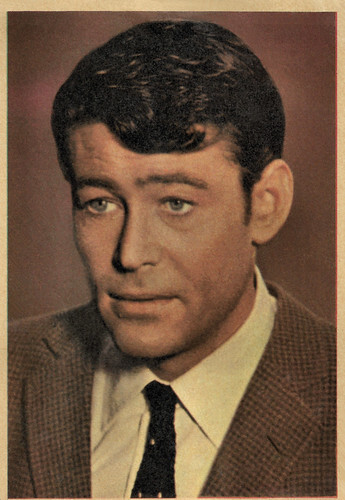
Spanish postcard by Postal Oscarcolor, no. 583.
One of Hollywood's most infamous party animals
Peter O‘Toole was one of the greatest actors of his generation. During his career, he received eight Academy Award nominations but never won the Oscar. TCM suggests that his flamboyant personal life was maybe to blame: “Known as one of Hollywood's most infamous party animals in his prime, O'Toole earned a reputation as a prodigious drinker alongside his contemporaries and fellow countrymen Richard Harris, Richard Burton , and Oliver Reed .
O'Toole's booze-fueled hijinks eventually took their toll, however, on both his career and his health. While the actor did manage to pick up his fifth Oscar nomination for the wickedly funny The Ruling Class (Peter Medak, 1972), the seventies were a low point in the actor's personal life and career.”
Once considered one of the most beautiful men ever to grace the silver screen only a decade earlier, O'Toole's alcoholism had cost him his looks. In 1979, his 20-year marriage to Irish actress Siân Phillips ended in divorce, when she left him for a younger man. Medical problems threatened to destroy his life. Originally he thought the problems were the result of his drinking but it turned out to be stomach cancer. He survived by giving up alcohol and by serious medical treatment.
He returned to the cinema with two triumphant performances: a sadistic, tyrannical director in the behind-the-scenes comedy The Stunt Man (Richard Rush, 1980), and an ageing swashbuckling film star strongly resembling Errol Flynn in My Favorite Year (Richard Benjamin, 1982). For both films, he received an Oscar nomination. On stage, he received good reviews as John Tanner in Man and Superman and as Henry Higgins in Pygmalion (1984), and he won a Laurence Olivier Award for his performance in Jeffrey Bernard is Unwell (1989).
However, O'Toole found meaningful film roles increasingly difficult to come by. He appeared in such duds as Supergirl (Jeannot Swarc, 1984), Creator (Ivan Passer, 1985) and Club Paradise (Harold Ramis, 1986), but fortunately, he also appeared in the much-garlanded grand epic The Last Emperor (Bernardo Bertolucci, 1987). The film about the final Emperor of China (John Lone) won the Oscar for Best Picture.
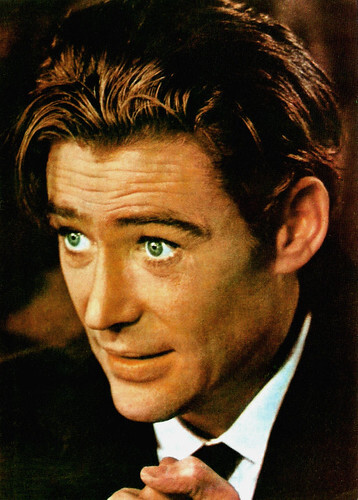
Romanian postcard by Casa Filmului Acin, no 384.
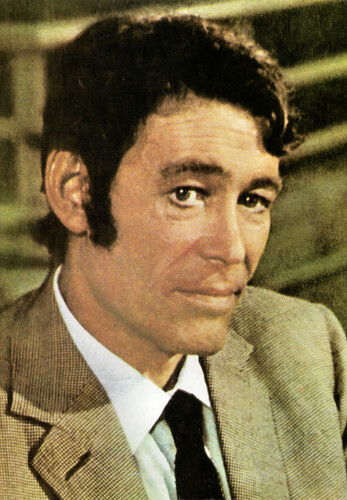
Romanian postcard by Casa Filmului Acin, no. 593.
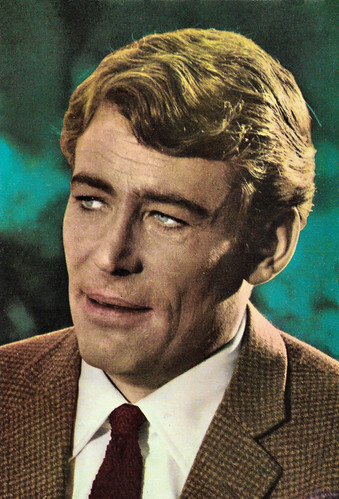
Spanish postcard by Postal Oscarcolor, no. 494.
Still in the game
After another series of lesser films, Peter O'Toole made again a comeback in the new decennium. In 1999 he won an Emmy Award for his role in the mini-series Joan of Arc (Christian Duguay, 1999). In 2003, he received a Special Oscar for lifetime achievement, an honour O'Toole only reluctantly accepted. He wrote the Academy a letter stating that he was “still in the game” and proved to be so in the following years.
In the blockbuster Troy (Wolfgang Petersen, 2004) he played the dying King Priam opposite Brad Pitt . In the BBC drama serial Casanova (2005), he appeared as the older version of the legendary 18th-century Italian adventurer. He was once again nominated for the Best Actor Academy Award for his portrayal of Maurice in the May-December romantic comedy Venus (Roger Michell, 2006), scripted by Hanif Kureishi. It was his eighth nomination.
O'Toole co-starred as the voice of food critic Anton Ego in the Pixar box office hit Ratatouille (Brad Bird, Jan Pinkava, 2007), an animated film about a rat with dreams of becoming the greatest chef in Paris. O'Toole appeared in the second season of Showtime's hit drama series The Tudors (2008), portraying Pope Paul III, who excommunicates King Henry VIII (Jonathan Rhys Meyers) from the church. This act leads to a showdown between the two men in seven of the ten episodes.
Peter O'Toole narrated the horror comedy Eldorado (Richard Driscoll, 2011), but in 2012, O'Toole released a statement that he was retiring from acting. Following a long illness, Peter O'Toole died peacefully in a London hospital in 2013.
He had two daughters, actresses Patricia O'Toole and Kate O'Toole (1960), from his marriage to Siân Phillips. He also has a son, actor Lorcan O'Toole (1983), by American model Karen Brown. For his body of work, he has won four Golden Globes, a BAFTA, and an Emmy.
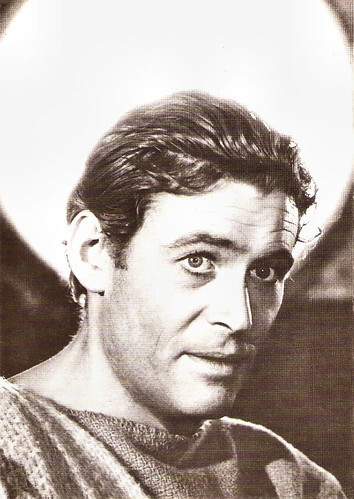
French postcard by Travelling Editions, no. CP 65. Peter O'Toole in The Bible: In The Beginning... (John Huston, 1966).
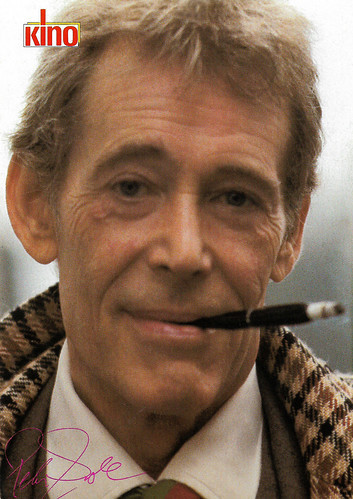
German autograph card by Kino.
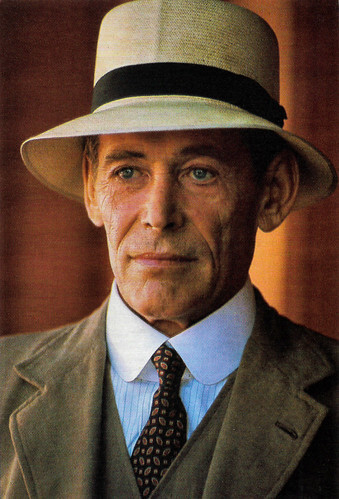
Dutch collectors card. Peter O'Toole in The Last Emperor (Bernardo Bertolucci, 1987).
Sources: Brian McFarlane (Encyclopaedia of British Film), Nathan Southern (AllMovie), (IMDb), TCM, Robert Pardi (Filmreference.com), Wikipedia and .

Dutch card. Photo: Columbia. Peter O'Toole in Lawrence of Arabia (David Lean, 1962).

West German postcard by Kolibri, Minden/Westf, no. 2630. Photo: 20th Century Fox. Peter O'Toole in How to Steal a Million (William Wyler, 1966).

Romanian postcard by Casa Filmului Acin. Peter O'Toole in The Bible: In The Beginning... (John Huston, 1966).
Intensity and zeal
Peter Seamus Lorcan O'Toole was born in 1932. According to IMDb , he was born in Connemara, Ireland. Other sources indicate Leeds, England, where he also grew up, as his birthplace. In his autobiography 'Loitering with Intent: the Child' (1992), O’Toole wrote that he was not certain of his birthplace, while he had birth certificates from two countries.
However, he was the son of Constance Jane (née Ferguson), a Scottish nurse, and Patrick Joseph O'Toole, an Irish metal platter, football player and racecourse bookmaker. As a boy, Peter decided to become a journalist, beginning as a newspaper copyboy. Although he succeeded in becoming a reporter, he discovered the theatre and made his stage debut at 17. He served as a radioman in the Royal Navy for two years.
From 1952 to 1954 he attended the Royal Academy of Dramatic Art as a scholarship student. His classmates included Albert Finney , Alan Bates and Richard Harris. While at RADA he was active in protesting the British involvement in the Korean War. Later in the 1960s, he would be an active opponent of the Vietnam War. O'Toole began working in the theatre, gaining recognition as a Shakespearean actor at the Bristol Old Vic and with the English Stage Company, before making an inconspicuous film debut in the Walt Disney production Kidnapped (Robert Stevenson, 1960), a faithful adaptation of the Robert Louis Stevenson classic.
Two years later, O'Toole was chosen by director David Lean to play Thomas E. Lawrence in Lawrence of Arabia (David Lean, 1962). The part of the conflicted British liaison officer caught at the centre of an Arab revolt made O'Toole an international superstar. Brian McFarlane observes in the Encyclopaedia of British Film : “It was a remarkable study in obsession, catching the right balance between mystic and man of action, bringing to the role kinds of intensity and zeal that few other British actors could have done”.
Peter O'Toole continued successfully in artistically rich films as well as less artistic but commercially rewarding projects. He was nominated as Best Actor for King Henry II in Becket (Peter Glenville, 1964) starring Richard Burton . Two years later he was nominated again for portraying Henry II, this time in The Lion in Winter (Anthony Harvey, 1968) alongside Katharine Hepburn .

Spanish postcard by Postal Oscarcolor, no. 279. Photo: Publicity shot for Becket (Peter Glenville, 1964) with Richard Burton .

Italian postcard by Rotalfoto, Milano (Milan), no. 278. Peter O'Toole in Lord Jim (Richard Brooks, 1965).

Spanish postcard by Postal Oscarcolor, no. 583.
One of Hollywood's most infamous party animals
Peter O‘Toole was one of the greatest actors of his generation. During his career, he received eight Academy Award nominations but never won the Oscar. TCM suggests that his flamboyant personal life was maybe to blame: “Known as one of Hollywood's most infamous party animals in his prime, O'Toole earned a reputation as a prodigious drinker alongside his contemporaries and fellow countrymen Richard Harris, Richard Burton , and Oliver Reed .
O'Toole's booze-fueled hijinks eventually took their toll, however, on both his career and his health. While the actor did manage to pick up his fifth Oscar nomination for the wickedly funny The Ruling Class (Peter Medak, 1972), the seventies were a low point in the actor's personal life and career.”
Once considered one of the most beautiful men ever to grace the silver screen only a decade earlier, O'Toole's alcoholism had cost him his looks. In 1979, his 20-year marriage to Irish actress Siân Phillips ended in divorce, when she left him for a younger man. Medical problems threatened to destroy his life. Originally he thought the problems were the result of his drinking but it turned out to be stomach cancer. He survived by giving up alcohol and by serious medical treatment.
He returned to the cinema with two triumphant performances: a sadistic, tyrannical director in the behind-the-scenes comedy The Stunt Man (Richard Rush, 1980), and an ageing swashbuckling film star strongly resembling Errol Flynn in My Favorite Year (Richard Benjamin, 1982). For both films, he received an Oscar nomination. On stage, he received good reviews as John Tanner in Man and Superman and as Henry Higgins in Pygmalion (1984), and he won a Laurence Olivier Award for his performance in Jeffrey Bernard is Unwell (1989).
However, O'Toole found meaningful film roles increasingly difficult to come by. He appeared in such duds as Supergirl (Jeannot Swarc, 1984), Creator (Ivan Passer, 1985) and Club Paradise (Harold Ramis, 1986), but fortunately, he also appeared in the much-garlanded grand epic The Last Emperor (Bernardo Bertolucci, 1987). The film about the final Emperor of China (John Lone) won the Oscar for Best Picture.

Romanian postcard by Casa Filmului Acin, no 384.

Romanian postcard by Casa Filmului Acin, no. 593.

Spanish postcard by Postal Oscarcolor, no. 494.
Still in the game
After another series of lesser films, Peter O'Toole made again a comeback in the new decennium. In 1999 he won an Emmy Award for his role in the mini-series Joan of Arc (Christian Duguay, 1999). In 2003, he received a Special Oscar for lifetime achievement, an honour O'Toole only reluctantly accepted. He wrote the Academy a letter stating that he was “still in the game” and proved to be so in the following years.
In the blockbuster Troy (Wolfgang Petersen, 2004) he played the dying King Priam opposite Brad Pitt . In the BBC drama serial Casanova (2005), he appeared as the older version of the legendary 18th-century Italian adventurer. He was once again nominated for the Best Actor Academy Award for his portrayal of Maurice in the May-December romantic comedy Venus (Roger Michell, 2006), scripted by Hanif Kureishi. It was his eighth nomination.
O'Toole co-starred as the voice of food critic Anton Ego in the Pixar box office hit Ratatouille (Brad Bird, Jan Pinkava, 2007), an animated film about a rat with dreams of becoming the greatest chef in Paris. O'Toole appeared in the second season of Showtime's hit drama series The Tudors (2008), portraying Pope Paul III, who excommunicates King Henry VIII (Jonathan Rhys Meyers) from the church. This act leads to a showdown between the two men in seven of the ten episodes.
Peter O'Toole narrated the horror comedy Eldorado (Richard Driscoll, 2011), but in 2012, O'Toole released a statement that he was retiring from acting. Following a long illness, Peter O'Toole died peacefully in a London hospital in 2013.
He had two daughters, actresses Patricia O'Toole and Kate O'Toole (1960), from his marriage to Siân Phillips. He also has a son, actor Lorcan O'Toole (1983), by American model Karen Brown. For his body of work, he has won four Golden Globes, a BAFTA, and an Emmy.

French postcard by Travelling Editions, no. CP 65. Peter O'Toole in The Bible: In The Beginning... (John Huston, 1966).

German autograph card by Kino.

Dutch collectors card. Peter O'Toole in The Last Emperor (Bernardo Bertolucci, 1987).
Sources: Brian McFarlane (Encyclopaedia of British Film), Nathan Southern (AllMovie), (IMDb), TCM, Robert Pardi (Filmreference.com), Wikipedia and .
Published on July 23, 2023 22:00
July 22, 2023
Juliette Mayniel
On 21 July 2023, doe-eyed French actress Juliette Mayniel (1936) passed away in San Miguel de Allende in Mexico. She appeared in 35 films and TV films between 1958 and 1978. Her film career made a jump start with two masterpieces, Claude Chabrol’s Les Cousins (1959) and the horror film Les Yeux Sans Visage (1960). Juliette Mayniel was 87.
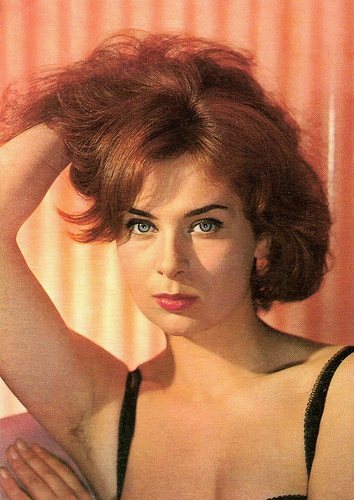
French postcard by E.D.U.G. (Editions du Globe), no. 45. Photo: Lucienne Chevert.
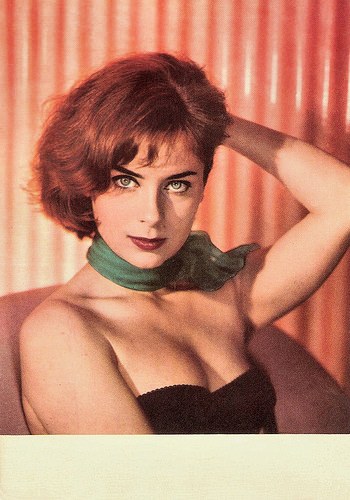
French postcard by Editions P.I., Paris, no. 1019. Photo: Sam Lévin.
Silver Bear
Juliette Mayniel was born in Saint Hippolyte, France in 1936.
Her first film appearance was an uncredited bit role in the comedy Premier mai/First of May (Luis Saslavsky, 1958) starring Yves Montand. Still, she had her breakthrough with her second film, the classic Nouvelle Vague film Les Cousins/The Cousins (Claude Chabrol, 1959). She is the girl between the two cousins, Jean-Claude Brialy and Gérard Blain . The film was an immediate success and remains one of Chabrol’s most striking films.
Next Mayniel had unwillingly her face removed by a mad doctor ( Pierre Brasseur ) in the masterpiece Les Yeux Sans Visage/Eyes Without a Face (Georges Franju, 1960). Hal Erickson at AllMovie calls the film ‘an unsettling, sometimes poetic horror film’: “Franju's haunting, muted handling of basic horror material is what lifts Eyes Without a Face out of the ordinary and into the realm of near-classic.”
James Travers adds at French Films : “Les Yeux sans visage differs from virtually all other films in the fantasy-horror genre. It doesn’t set out to shock us with gruesome images or insult our intelligence with an implausible plot or fantastic characters. Everything it shows us is frighteningly plausible, but presented to us in a dreamlike manner which, if anything, softens the horror of the situation. Crucially, it is not evil which provides the stimulus for the horror, but love, the love of a father determined to give his daughter back her life. In the end, the film’s haunting poetry, not its horror connotations, has the deepest impact on the spectator.”
In the compelling WW II drama Kirmes/The Fair (Wolfgang Staudte, 1960) a young German soldier ( Götz George ) who had often been ordered to execute women and children deserts the army during WW II and tries to find a hiding place in his native village. He is sheltered by a priest and a young French woman (Mayniel) with whom he falls in love. At the 10th Berlin International Film Festival, Mayniel won the Silver Bear for Best Actress for her role.
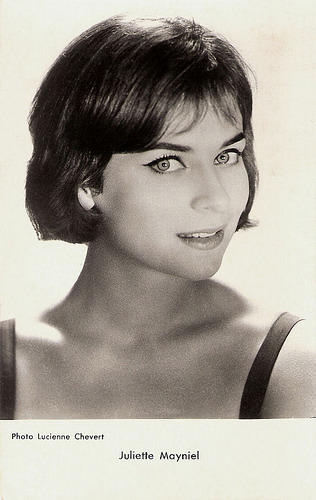
French postcard by Editions P.I., Paris, no. 1019A, presented by Les Carbones Korès Carboplane. Photo: Lucienne Chevert.
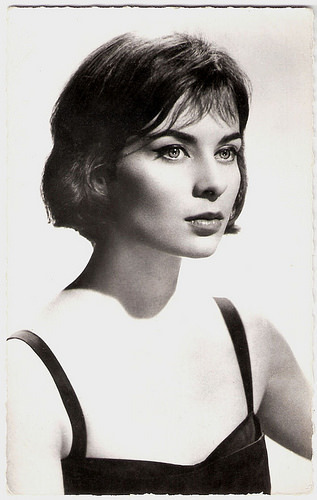
French postcard by Editions du Globe, Paris, no. 835. Photo: Lucienne Chevert.
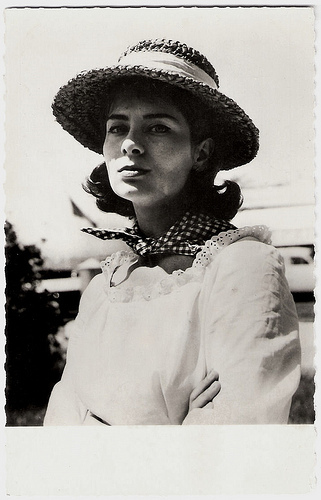
French postcard by Editions P.I., Paris, no. 1014. Photo: Noa.
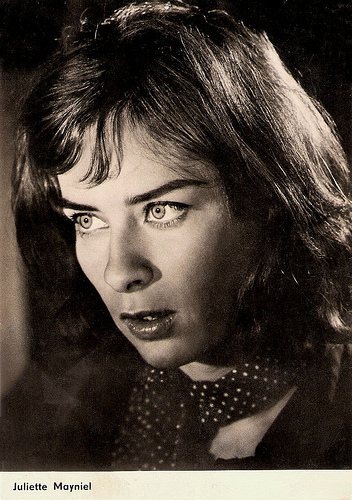
East-German starcard by VEB Progress Film-Vertrieb, Berlin, no. 2.003, 1964. Photo: publicity still for Kirmes/The Fair (Wolfgang Staudte, 1960).
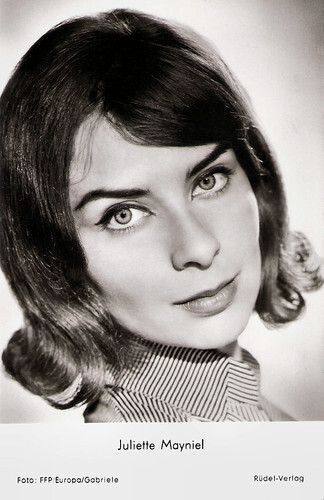
West German postcard by Rüdel-Verlag, Hamburg-Bergedorf, no. 3073. Photo: FFP / Europa / Gabriele. Juliette Mayniel in Kirmes/The Fair (Wolfgang Staudte, 1960).
Peplum and Giallo
Juliette Mayniel had a small part in Les Godelureaux/The Wise Guys (Claude Chabrol, 1961), a Nouvelle Vague drama about a trio of youths (including Jean-Claude Brialy and Bernadette Lafont ) looking to debunk hypocrisy wherever they find it. In Italy, she appeared in the Peplum La Guerra di Troia/The Trojan Horse (Giorgio Ferroni, 1962), a retelling of the final year of the siege of Troy from the point of view of Aeneas ( Steve Reeves ). Bruce Eder at AllMovie calls it: “one of the best examples of Italy's sword-and-sandal genre”.
She was reunited with director Claude Chabrol for Ophelia (1962), a curious, modern version of Hamlet, co-starring André Jocelyn and Alida Valli , and for Landru/Bluebeard (Claude Chabrol, 1963), a black comedy based on the dastardly deeds of serial killer Henri-Desire Landru (Charles Denner), who wined, dined, scammed, and dismembered over 10 women (including Danielle Darrieux and Michèle Morgan ) during WW I.
Juliette Mayniel was married to Robert Auboyneau till 1964. From 1964 until 1968 she was the partner of actor Vittorio Gassman . They had a son, actor Alessandro Gassman. During this period Mayniel didn’t work in the cinema. In 1968 she returned as Circe in the Italian TV series L'odissea/The Odyssee (Franco Rossi, Piero Schivazappa, Mario Bava, 1968) based on Homer and starring Bekim Fehmiu and Irene Papas . She then appeared in the drama Scusi, Facciamo L'Amore?/Listen, Let's Make Love? (Vittorio Caprioli, 1968) about a young gigolo (Pierre Clementi). In Quella Piccola Differenza/That Little Difference (Duccio Tessari, 1970) she was the wife of a virile macho (Pino Caruso) who changes in three days into a woman.
Mayniel played the female lead in the Bud Spencer comedy Piedone Lo Sbirro/A Fistful of Hell (Steno, 1973) and in the soft sex comedy Peccati in Famiglia/Sins in the Family (Bruno Gaburro, 1975) opposite Michele Placido. On TV she appeared in Un anno di scuola/A Year of School (Franco Giraldi, 1977) with Mario Adorf , and in the mini-series Madame Bovary (Daniele D'Anza, 1978) with Carla Gravina as the heroin of Gustave Flaubert’s novel.
Her last film roles were a supporting part in the Giallo thriller Solamente Nero/The Blood Stained Shadow (Antonio Bido, 1978) with Stefania Casini and Massimo Serato , and eight years later another small part in Molly O (Gino Bortoloni, 1986). As herself, Juliette Mayniel appeared in the TV documentaries Portrait de Vittorio Gassman/Portrait of Vittorio Gassman (Pierre Laforêt, 1979) and Di padre in figlio/From Father To Son (Alessandro Gassman, Vittorio Gassman, 1982). Juliette Mayniel died on 21 July 2023, at the age of 87.
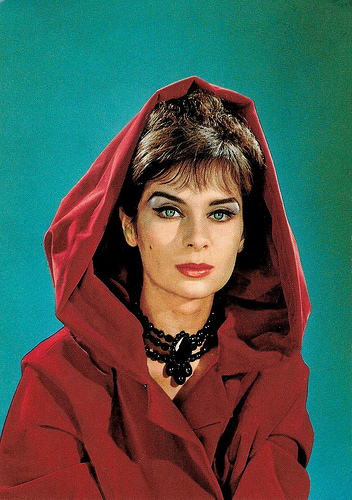
French postcard by Editions P.I., Paris, no. 1060. Photo: Sam Lévin.
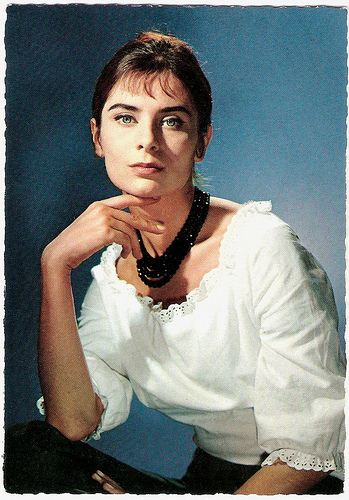
French postcard by E.D.U.G. (Editions du Globe), no. 72. Photo: Sam Lévin.
Sources: James Travers (French Films), Hal Erickson (AllMovie), John Conomos (Senses of Cinema), Wikipedia, and IMDb.

French postcard by E.D.U.G. (Editions du Globe), no. 45. Photo: Lucienne Chevert.

French postcard by Editions P.I., Paris, no. 1019. Photo: Sam Lévin.
Silver Bear
Juliette Mayniel was born in Saint Hippolyte, France in 1936.
Her first film appearance was an uncredited bit role in the comedy Premier mai/First of May (Luis Saslavsky, 1958) starring Yves Montand. Still, she had her breakthrough with her second film, the classic Nouvelle Vague film Les Cousins/The Cousins (Claude Chabrol, 1959). She is the girl between the two cousins, Jean-Claude Brialy and Gérard Blain . The film was an immediate success and remains one of Chabrol’s most striking films.
Next Mayniel had unwillingly her face removed by a mad doctor ( Pierre Brasseur ) in the masterpiece Les Yeux Sans Visage/Eyes Without a Face (Georges Franju, 1960). Hal Erickson at AllMovie calls the film ‘an unsettling, sometimes poetic horror film’: “Franju's haunting, muted handling of basic horror material is what lifts Eyes Without a Face out of the ordinary and into the realm of near-classic.”
James Travers adds at French Films : “Les Yeux sans visage differs from virtually all other films in the fantasy-horror genre. It doesn’t set out to shock us with gruesome images or insult our intelligence with an implausible plot or fantastic characters. Everything it shows us is frighteningly plausible, but presented to us in a dreamlike manner which, if anything, softens the horror of the situation. Crucially, it is not evil which provides the stimulus for the horror, but love, the love of a father determined to give his daughter back her life. In the end, the film’s haunting poetry, not its horror connotations, has the deepest impact on the spectator.”
In the compelling WW II drama Kirmes/The Fair (Wolfgang Staudte, 1960) a young German soldier ( Götz George ) who had often been ordered to execute women and children deserts the army during WW II and tries to find a hiding place in his native village. He is sheltered by a priest and a young French woman (Mayniel) with whom he falls in love. At the 10th Berlin International Film Festival, Mayniel won the Silver Bear for Best Actress for her role.

French postcard by Editions P.I., Paris, no. 1019A, presented by Les Carbones Korès Carboplane. Photo: Lucienne Chevert.

French postcard by Editions du Globe, Paris, no. 835. Photo: Lucienne Chevert.

French postcard by Editions P.I., Paris, no. 1014. Photo: Noa.

East-German starcard by VEB Progress Film-Vertrieb, Berlin, no. 2.003, 1964. Photo: publicity still for Kirmes/The Fair (Wolfgang Staudte, 1960).

West German postcard by Rüdel-Verlag, Hamburg-Bergedorf, no. 3073. Photo: FFP / Europa / Gabriele. Juliette Mayniel in Kirmes/The Fair (Wolfgang Staudte, 1960).
Peplum and Giallo
Juliette Mayniel had a small part in Les Godelureaux/The Wise Guys (Claude Chabrol, 1961), a Nouvelle Vague drama about a trio of youths (including Jean-Claude Brialy and Bernadette Lafont ) looking to debunk hypocrisy wherever they find it. In Italy, she appeared in the Peplum La Guerra di Troia/The Trojan Horse (Giorgio Ferroni, 1962), a retelling of the final year of the siege of Troy from the point of view of Aeneas ( Steve Reeves ). Bruce Eder at AllMovie calls it: “one of the best examples of Italy's sword-and-sandal genre”.
She was reunited with director Claude Chabrol for Ophelia (1962), a curious, modern version of Hamlet, co-starring André Jocelyn and Alida Valli , and for Landru/Bluebeard (Claude Chabrol, 1963), a black comedy based on the dastardly deeds of serial killer Henri-Desire Landru (Charles Denner), who wined, dined, scammed, and dismembered over 10 women (including Danielle Darrieux and Michèle Morgan ) during WW I.
Juliette Mayniel was married to Robert Auboyneau till 1964. From 1964 until 1968 she was the partner of actor Vittorio Gassman . They had a son, actor Alessandro Gassman. During this period Mayniel didn’t work in the cinema. In 1968 she returned as Circe in the Italian TV series L'odissea/The Odyssee (Franco Rossi, Piero Schivazappa, Mario Bava, 1968) based on Homer and starring Bekim Fehmiu and Irene Papas . She then appeared in the drama Scusi, Facciamo L'Amore?/Listen, Let's Make Love? (Vittorio Caprioli, 1968) about a young gigolo (Pierre Clementi). In Quella Piccola Differenza/That Little Difference (Duccio Tessari, 1970) she was the wife of a virile macho (Pino Caruso) who changes in three days into a woman.
Mayniel played the female lead in the Bud Spencer comedy Piedone Lo Sbirro/A Fistful of Hell (Steno, 1973) and in the soft sex comedy Peccati in Famiglia/Sins in the Family (Bruno Gaburro, 1975) opposite Michele Placido. On TV she appeared in Un anno di scuola/A Year of School (Franco Giraldi, 1977) with Mario Adorf , and in the mini-series Madame Bovary (Daniele D'Anza, 1978) with Carla Gravina as the heroin of Gustave Flaubert’s novel.
Her last film roles were a supporting part in the Giallo thriller Solamente Nero/The Blood Stained Shadow (Antonio Bido, 1978) with Stefania Casini and Massimo Serato , and eight years later another small part in Molly O (Gino Bortoloni, 1986). As herself, Juliette Mayniel appeared in the TV documentaries Portrait de Vittorio Gassman/Portrait of Vittorio Gassman (Pierre Laforêt, 1979) and Di padre in figlio/From Father To Son (Alessandro Gassman, Vittorio Gassman, 1982). Juliette Mayniel died on 21 July 2023, at the age of 87.

French postcard by Editions P.I., Paris, no. 1060. Photo: Sam Lévin.

French postcard by E.D.U.G. (Editions du Globe), no. 72. Photo: Sam Lévin.
Sources: James Travers (French Films), Hal Erickson (AllMovie), John Conomos (Senses of Cinema), Wikipedia, and IMDb.
Published on July 22, 2023 22:00
Paul van Yperen's Blog
- Paul van Yperen's profile
- 13 followers
Paul van Yperen isn't a Goodreads Author
(yet),
but they
do have a blog,
so here are some recent posts imported from
their feed.



